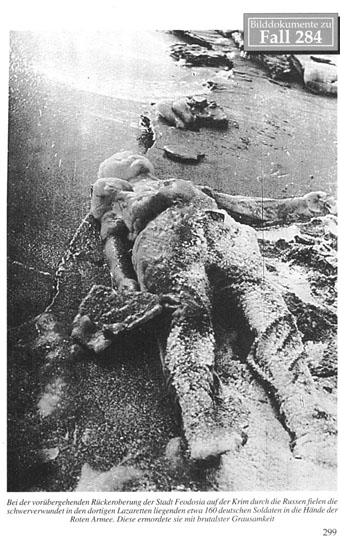
Page 299]
Pictorial documentation to Case 284
During the temporary occupation of the city of Feodosia in the Crimea by the Russians, a number of severely wounded in the local field hospital about 160 German soldiers fell into the hands of the Russian Army. These were murdered with the most brutal cruelty.
Page 300]
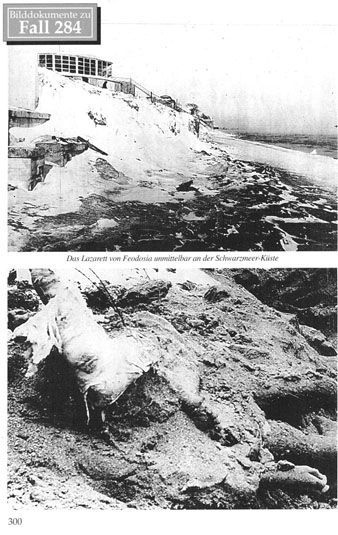
Pictorial documentation to Case 284
The field hospital of Feodosia immediately on the coast of the Black Sea
Page 301]
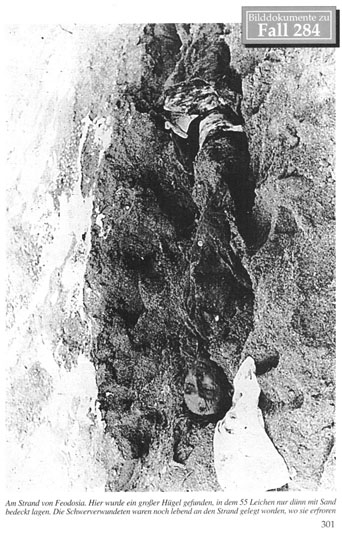
Pictorial documentation to Case 284
On the Feodosia. Here a a large mound was found, in which 55 bodies lay covered only with sand. The severely wounded were lain on the beach while still alive, where they froze to death.
Page 302]
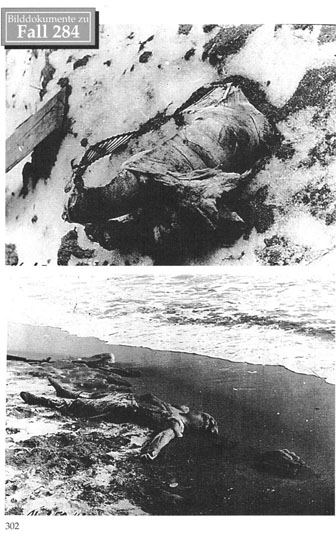
Pictorial documentation to Case 284
Page 303]
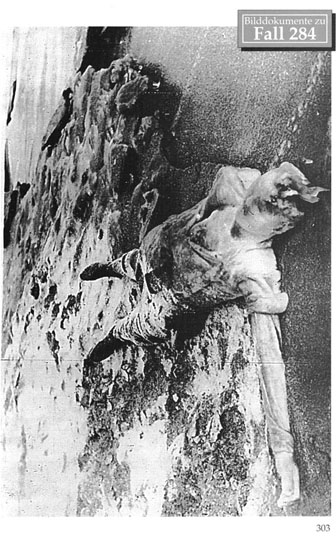
Pictorial documentation to Case 284
Page 304]
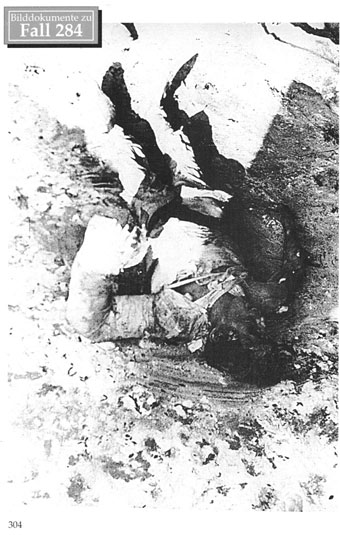
Pictorial documentation to Case 284
Page 305]
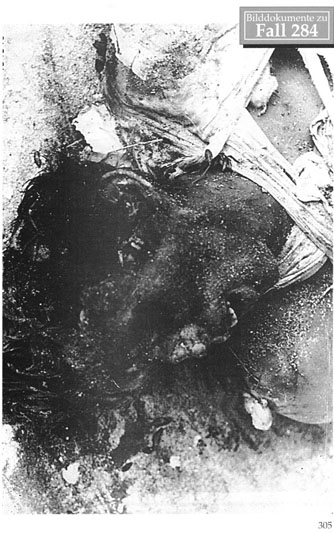
Pictorial documentation to Case 284
Page 306]
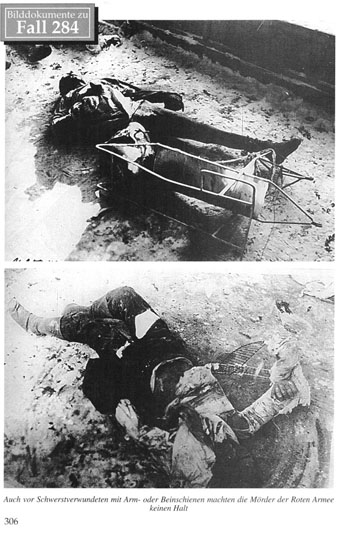
Pictorial documentation to Case 284
The murderers of the Red Army had no mercy even on the most severely wounded.
Page 307]
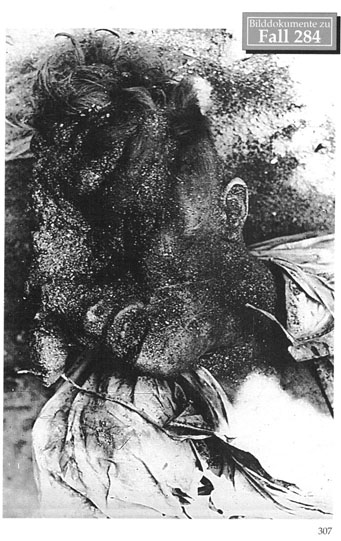
Pictorial documentation to Case 284
Page 308]
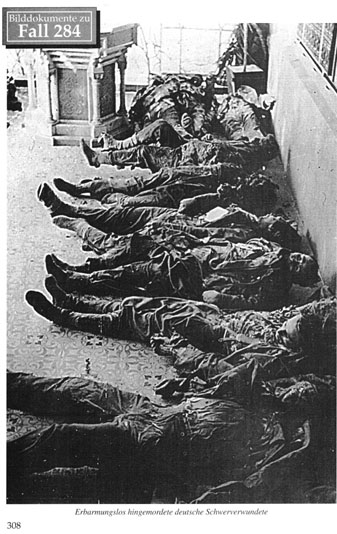
Pictorial documentation to Case 284]
Mercilessly murdered German severely wounded
Page 309]
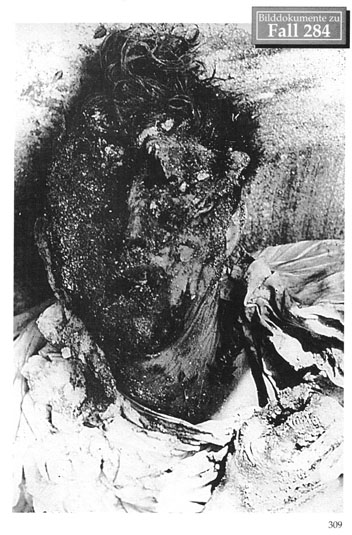
Pictorial documentation to Case 284
Page 310]
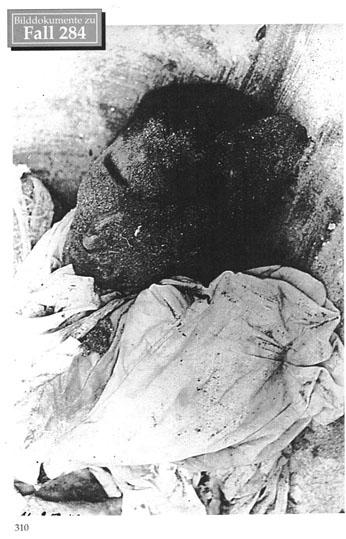
Page 311]
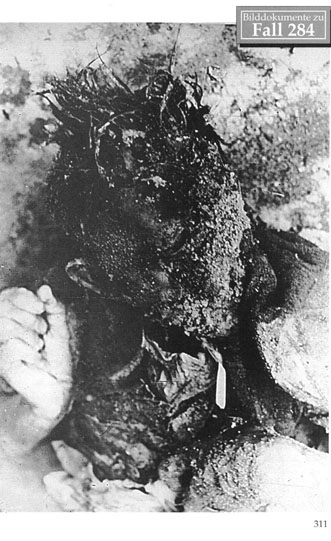
Pictorial documentation to Case 284
Page 312]
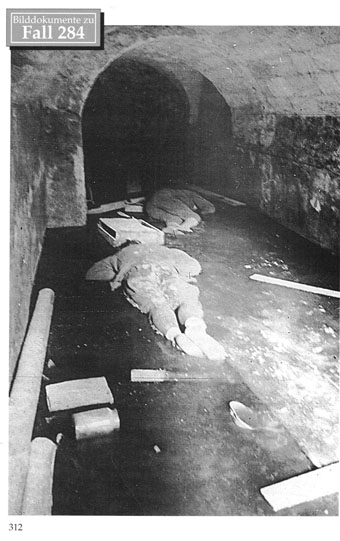
Pictorial documentation to Case 284
Page 313]

Pictorial documentation to Case 284
Page 314]
It was charged by the local German command post immediately after German advance into Feodosia first to care for the Russian wounded remaining behind in the Russian field hospital. During the following time period, he then also made an effort to take care of the German wounded as well. After the surrender of the city of Feodosia by the Germans on 29 December 1941, Russian marines and later infantry men from the Red Army came as well. The marines ran amok throughout the city, completely drunk. Still on the first day, they went to the field hospital opposite the castle and shot the German wounded lying there, according to his estimate about 30 to 35 German soldiers. On the third day of the occupation, i.e. on 1 January 1942, the general order was issued to shoot all Germans found in the reoccupied area. Commandos were then created by the commissars and N.K.V.D. who also shot all the German wounded lying in the other field hospitals and casualty collection centers. About 60 German soldiers lay in the city hospital, about 35 in the castle and about 30 to 40 in the Technikum. According to his estimate, about 160 German soldiers, mostly wounded, were shot during the reoccupation of the city of Feodosia by the Russians. Later the shot men were laid about indiscriminately in the open, there were no burials. A large number of the dead men lay around more than two weeks on the places before being buried in an improvised manner.
The Russian military doctor, according to the announcement of the Russian civilian physician Dimitrijew, showed not the slightest mercy to the helpless wounded. On the contrary, they were prepared to assist in the shootings. Dimitriejew sounded out the commissar cautiously of the 9th Russian Corps, who once came into the field hospital supervised by him after the occupation of Feodosia by the Russians, as to why all the German wounded were being killed. The commissar, in the presence of other political commissars who had come with him, replied that this procedure was based on Stalin’s speech of 7 November 1941, in which Stalin had declared that all Germans or combatants on Russian soil must be wiped out. The commissar further stated that based on this speech by Stalin, the commissars had given instructions to the soldiers to exterminate all combatants; the commissar found it entirely proper that the German wounded should be murdered.
The Russian nurse Assan Kalafatow, who acted as nurse in the German hospital in the Villa Stamboli after the fist occupation of Feodosias by German troops and who also remained there when the Russians withdrew again, reports for his part as witness that had been 26 German wounded in the field hospital in the Villa Stamboli after the German withdrawal. After the Russian occupation of the city, the field hospital was initially placed under the supervision of a Russian infantry officer. As long as he was there, the German wounded were still properly fed and cared for in the field hospital concerned. After about four days, however, the Russian infantry officer was replaced by an officer in the Russian marines. When this officer in the marines in the field hospital
Page 316]
he was also adament that the German wounded were to receive no further treatment. On 6 January 1942, about four in the afternoon, this Russian marine officer then appeared with twelve marines, enlisted men, who shot two men from the Russian medical personnel of the field hospital because they had cared for the German wounded. The witness Kalafatow and two other Russian nurses could only save themselves from the same fate by fleeing from the field hospital. When he went into the Villa Stamboli to see what was going on, on 7 January, at about two o’clock in the afternoon, he found none of the wounded men still in the room in the cellar where they had previously been housed (because of the bombardment of the city), with their beds; rather, he found them all shot dead in another room in the cellar. Several of them were said to have shown signs of life; one wounded man even called out for water. He and another stretcher bearer were, as a result, said to have carried him back into the cellar, fitted out as a field hospital, laid him on a bench and gave him water to drink. Then they had to withdraw, because they feared the return of the sailors. A few hours later, it turned that this German wounded man whom they had treated, had, in the meantime, been carried out of the building, together with the other shot men. The witness believes that they were all taken to the vicinity of the cemetery, where many German soldiers were lain to rest later.
Also another Russian witness, the worker Konstantin Bursud, from Feodosia, in accordance with the testimony of Doctor Dimitriew and nurse Kalafatow, describes the brutality of the Russian occupation troops. From his hiding place, he personally saw the murder of about twelve German wounded men who had been brought to the square behind the field hospital by truck and were killed there by cut and thrust weapons. He reports with certainty that no shots were fired at this location and that he heard the fearful screams of the Germans being murdered in this terrible manner at this location. The Russian sailors themselves bragged of having thrown a number of German seriously wounded out of the windows and then having poured water over them, so that they would freeze in the cold.
Two German witnesses, Gefreiter Niedermair and Rifleman Scheid, in the record of 24 January 1942, describe their own experiences after the Russian occupation of Feodosia. In a narrow cell, together with many other inmates, they both expected, for days, to be shot by the Russian occupation troops, and in fact they only avoided being murdered by lucky accident of fate. The witness Niedermair gives a description of the shooting of about 23 German comrades, who were killed on the order of a Russian commissar, by means of gun shots to the neck and shoulder.
Page 317]
Court of the AOK 11 Army Headquarters, 24 January 1942
Reserve Auxiliary List 13/42
Transcription of shorthand
Present: Judge Advocate Dr. Hagemann, acting judge
Gefreiter Engelmann, generally obligated Recording Secretary
The following persons appeared in the 2/610 [?] (Motorized) Military Field Hospital, 1st Surgical Division. There they met Gefreiter Anton Niedermair and riflemen Johann Scheid. These were interrogated as follows after being informed of the significance of the oath.
As to my person: my name is Anton Niedermair, 36 years old, Catholic religion, innkeeper in civilian life, in Munich.
“As to the facts: I am a cook with the 2nd Company, 551st Military Transport Division and found myself at our casualty collection center in Feodosia at the end of December 1941. On 29 December, I was ordered to look out for the prisoners working at the casualty collection center. They were 6 men. When the Russians landed in the early morning and started shooting, I took the prisoners out of the room in which they were staying, and ran with them into an anti-shrapnel ditch. The enemy also fired artillery. There were 6 prisoners. We sat in the ditches until about half past 10 o’clock. At around this time, a lot of Russian soldiers came along. One of these prisoners went over to them. The Russians made a motion to shoot us. They motioned with their rifles and their bayonets. Our prisoners talked to them. They were obviously saying that they had been treated well and that we shouldn’t be shot. With me was Rifleman Frebel and Gefreiter Rauch, both from my platoon. We were then taken to the harbor and then to the command post. On the way, nothing happened to us. There, we were interrogated by a strongly Jewish looking man in a sailor’s uniform. He spoke good German. This Jew was only the interpreter. The interrogation was directed by an officer or commissar. They asked us what kind of German troops were stationed in Feodosia. I told them I didn’t know. I really didn’t know which troops lay in Feodosia. They asked whether the German soldier was satisfied. I said that so far nobody had noticed that the German soldier was not satisfied. Frebel was interrogated in front of me. The Jew and the commissar didn’t treat us badly. They put no pressure on us. After the interrogation, we were brought to a garage and in the evening into the house, where the SS had lain. We were locked up in a cell. It was a two-man cell. First, there were four men in it. There was a broad plank-bed in the cell, in which all four of us we could lie down. The Russian guards brought us blankets, one for each of us. In the beginning, we were taken out to relieve ourselves, later, when the civilians were taken out, we received a bucket. Through the window, I saw wounded German soldiers being taken to the prison. What happened to them, I don’t know. That was in the days when shots were being fired inside the prison. I therefore assume that the wounded men were shot. Gefreiter Rauch was taken out to bandage wounded men.
“Finally, there were still 13 men in the cell. The civilians were taken out. Then there were only German prisoners left. I didn’t know the other comrades. On 16 January in the evening, our boots were taken from myself and 2 of my comrades. We had already taken them off. About 23 hours, the soldier Anton Mueller and an auto mechanic were taken out of the cell. They and Rifleman Frebel were already dressed therefore in Russian uniforms, trousers and jacket. I assume that the Russians did that because these comrades were put to work repairing cars. They were transported away in a truck. I can only assume that they were transported to the Caucausus. They are probably all dead, too. At around 23 hours, I and Frebel and the other comrades were taken away. We heard shots at short intervals. We were taken out individually each by 2 Russian soldiers. I was the 11th. I had to go along the floor to the right, then a few steps downstairs into the cellar, into a room filled with firewood. There I saw, in the light of a flashlight, German soldiers lying there after being shot. A Russian in a blue uniform, obviously a
Page 318]
Commissar, stepped up to me, put a pistol at my neck and fired. I felt a heavy blow and lost consciousness, but only for a short time. When I came to again, I heard shots being fired in the cell above. Obviously the commissar had just shot the last comrades in the cell above. I lay in the cell the entire night and until well into the next day, about 17 or 18 hours, in the cellar. Then it got so cold in the cellar that I couldn’t stand it. One comrade was still alive. We noticed that the Russians had disappeared. The comrade went upstairs, to look for blankets. I dragged myself on all fours up the stairs. Due to loss of blood, I was very weak. Finally, there were about 7 of us, still alive. About 23 comrades had been shot. They had bullet wounds in the neck, shoulder and other places. We then remained the next night in our cell. Early on the 18th some civilians came along. They brought us a bit of water. We were completely exhausted. We were then taken away by German troops.
We were also filmed twice, in the courtyard. We had to march past with raised hands.”
Read out, approved and signed. Anton Niedermair
The witness was properly sworn.
Two: Rifleman Johann Scheid.
"As to my person: my name is Johann Scheid. I am 27 years old, a farmer in civilian life, at Berg bei Euresberg in Upper Bavaria, Catholic.
"As to the facts: I belong to the Ist Company, 97th Infantry Regiment. My Battalion lay in and around Feodosia. On 31 December I got sick with diarrhea and had lain myself in a hay rick with the permission of my lieutenant. I felt very miserable and fell asleep. When it got dark, I got up. Some Russians approached. My comrades had apparently forgotten me or could not find me. The Company had just taken up a position. The Russians took my valuables and my papers. They didn’t mistreat me in any way. They took me into the village and from there, with several civilians, including a woman, to a locality. I don’t know why the civilians were being taken away. I couldn’t talk to them. First, we were housed in a stall, then the Russians brought the civilians and myself into the house. There we lay on the bare earth. We got nothing to eat. After one and a half days, we were taken to Feodosia. Nothing happened to me on the march. Nothing happened to the civilians either. In Feodosia, I was put into another cell with some German POWs already in it. There were 32 men in the cell. The cell was about 4 x 4 meters square. We couldn’t all lie down at the same time, sometimes we had to sit. Each day, we got a warm soup, once a day. First, it was quite good with fat, afterwards it got thinner and thinner. We were also taken out to work, fetching water and cleaning out the rooms. 4 comrades, Otto Frebel, Anton Müller, Rauch and an auto mechanic, whose name I do not know, were dressed in Russian uniforms. I don’t know what happened to them. We assume that they were transported to the Caucasus.
“At 16 hours, we were taken out of the cell one at a time. Before I was fetched out, I heard shots outside. I was put in a room in the cellar with 30 centimeters of water in it. There was the body of a German soldier already lay dead in the water. I was suddenly shot in the neck and lost consciousness for a short time. I can’t say who shot me. I regained consciousness and noticed that another comrade had been shot in the same room, I also heard shots from another room in the cellar. I stayed lying there until 7 o’clock and then dragged myself upstairs into the cells where I was kept before. The Russians weren’t there. I slept in the cell until the afternoon, until some Russian civilians appeared and gave us cakes, tea and lentil soup. One comrade died in the cell while we were lying upstairs. We were found by German troops next morning. The bullet entry wound in my case is directly in the middle of the neck, the bullet is still lodged in the left cheek.”
Read out, approved and signed. Signed: Schutze Scheid, Johann
The witness was properly sworn.
Signed: Gefreiter Engelmann. signed: Dr. Hagemann, Judge Advocate General.
For the correctness of the transcription: Gefreiter Engelmann.
Page 319]
Court of the 22nd Division Div. Command Post, 24 January 1942
Present: 1. Stabsfeldwebel Dr. Diderichs, Army judge advocate.
In the matter under investigation, i.e. violations of international law by Russian troops, the following person was interviewed as a witness in the field hospital. The witness was acquainted with the object of the investigation and informed of the significance of the oath to be sworn. He was then interrogated as follows:
“My name is Wilhelm Törber, born 11 January 1906 in Bremen, Evangelical religion, Gefreiter, 22nd field hospital, I answer the other credibility questions in the negative.
“I declare as follows as to the subject of my interrogation:
“On 26 December 1941, I, as driver of the vehicle, together with Corporal Rüter, had to make a service trip to Kertsch.
”At Feodosia, we couldn’t go any further. Corporal Rüter drove with a jeep to Kertsch, while I remained in Feodosia. I was assigned some lodgings by the local command post in Feodosia by Russians, who made a decent impression but who spoke no German.
“In the night of 29 December, I suddenly heard heavy firing. I assumed it was a general air alert, and went to the cellar of the house. I stayed there until morning, about 7 or 8 o’clock. When I went out again, I could no longer leave the house because the road was under artillery fire. About 9 o’clock, the Russians came through the streets. So I remained in the house during the day. The home owners had fled in the meantime.
“On the next day, 30 December, about 9 o’clock in the morning, I was taken out of the house and taken to the local command post. There was an interpreter there who looked very Jewish. He explained that all officers and non-commissioned officers would be shot immediately. The interrogation at the local command post was very brief. I was asked, how many troops there were in Feodosia, which unit they were from, and if I had fired any shots. I explained that I belonged to no unit, that I was a medic, that I had not fired any shots and didn’t know how many troops there were in Feodosia.
“After the interrogation, I was taken to a garage with two dead German soldiers in it, who, from the appearance of their wounds, had obviously just been shot. There were still 15-20 men in the garage. These told me that the two German soldiers had been shot in the neck by the Russian soldiers. We were taken out of the garage under heavy guard to the local prison. There we were all put into a cell together. The cell was 2-3 m wide and 5-6 m long. On the lateral side of the room was a plank-bed. We received no straw and no blanket and the room was unheated. I spent 2 days in the room. After that, we were separated according to profession. Together with 5-6 other truck drivers, I was put in another cell, measuring about 4 x 5 m. The other men in the cell were Tatars, Greeks, Rumanians, Russians and two women. The room was so small compared to the number of persons in it that I could only sleep standing up, for the entire period of the next few days. We were fed irregularly, mostly only once a day -- a thin water soup with clumps of meal. There was no bread at all. On the first days of our captivity, we had to eat snow, since the water was frozen. When I wanted to go outside I was taken outside with a guard of three men. About 8-10 days after being captured, we were taken outside. We had to march along the street with out hands up. We were filmed while we marched in this fashion. During this period, the Russians filled a German army vehicle with underclothing and fur coats and filmed the vehicles, too. Moreover, the Russian soldiers, especially the marines, were decent to us, and brought us cigarettes from time to time. The officers and Jews, on the other hand, showed their hatred of us.
“During the course of the day on 16 January 1942, looking out the window of the prison, we noticed a certain uncertainty among the Russians on the street. In the night of 17 January, a few of us at first, then all of us, were asked for our boots. About an hour later, the prisoners were led out of the cells individually. I myself was one of the last. I was taken to the cellar. On the steps that led to the cellar one of them grabbed me by the throat. Below, in the cellar, I was shot from behind. The shot hit me right above the neck and penetrated the right cheek. In the first moment, I was unconscious but came to
Page 320]
after a few seconds. After that, another soldier was brought into the cellar and they shot him in the same way. Nobody came to see whether we were dead. The cellar had a German soldier and a Rumanian in it, both dead. Five soldiers were still alive. I stayed in the cellar at first and only went upstairs later, when everything was quiet, after fixing up some improvised bandages, to look for a blanket, because it was so cold. Five Russian civilians brought us something to drink. Of the 40-50 men who, by my estimate, were there in the beginning, there were only 8 men left. I am unable to state the names of the individual soldiers. On 18 January, about 15 hours, the German troops came into the city. I was then properly bandaged and transported away to Simpferopol, to the 22nd field hospital, to which I belonged.
“During my captivity all my things, wedding ring, wallet, watch, knife and camera were taken away.”
Read through, approved and signed. Signed: Törber, Gefreiter.
The witness was properly sworn.
Concluded. Signed: Dr. Diderichs. Signed: Lehmann.
Case 285
Court of the 50th Infantry Division Local Bivouac, 10 January 1942
General List 4/42
Participants: Judge Advocate Dr. Herzog, acting judge
Gefreiter K. Roleff, documentary secretary.
In response to an order, there appeared the following persons: Officer Alfons Bartussek, Obergefreiter Geiswinkler, Gefreiter Behlich, Gefreiter Haberland.
The above named persons were informed of the subject matter of the interrogation, warned to tell the truth and informed of the significance of the oath as well as of the criminal nature of any violation of the oath.
They were interrogated and testified as follows:
1st witness: Officer Bartussek.
”As to my person: Alfons Bartussek, 28 years old, Catholic, officer with the 150th Butcher Company.
“As to the facts: I was ordered to fetch meat for the 50th Infantry Division from Akmetschek, about 70-80 km north of Jewpatoria on the Crimea. I had the three soldiers who appeared with me. On 1 January 1942, we were shot at with our herd of animals on the lake, but we got through to Jewpatoria. There we took up quarters in the vicinity of the theater and stayed there to give the animals some rest. During the night from 4 to 5 January 1942, there was an alarm. The Russians landed under the protection of warships. I participated in these fire fights with my men and later participated in securing the area. From where I stood, I could see the German field hospital under attack by the Russians. I saw wounded men fleeing, if they could walk. I as saw the truck drive away with wounded men in it. On 6 January 1942, when German infantry penetrated the city, I saw a truck standing near the theater, with seriously injured men in it. The Russians dragged them down off the truck. They lay all over the place. They were badly mutilated. They had their eyes gouged out, noses and ears cut off. I could see that one of them had had his entire abdomen slit open. Another had had his skull completely split open. In the park, in front of the theater, lay a German wounded man, whose skull was split open so that the brain had been projected outwards and lay next to him. On the whole, I saw at least 15 cruelly mutilated German soldiers from the field hospital; you could see they were from the field hospital because they were dressed only in underclothing and wore bandages."
Read out and approved.
Pictorial documentation to Case 285
Jewpatoria on the Crimea: This city was also temporarily retaken by the Russians. Among other things, seriously wounded men were taken down off a truck and cruelly mutilated.
Page 322]

Pictorial documentation to Case 285
Page 323]
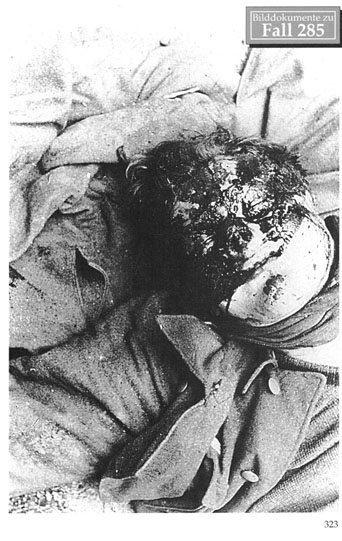
Pictorial documentation to Case 285
Page 324]
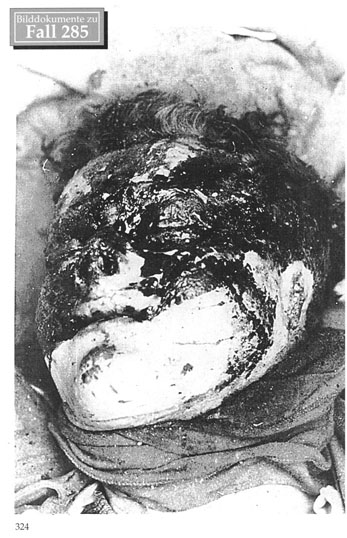
Pictorial documentation to Case 285
Page 325]

Pictorial documentation to Case 285
Page 326]
2nd witness: Obergefreiter Geiswinkler
“As to my person: Anton Franz Karl Geiswinkler, 25 years of age, Catholic, Obergefreiter with the 150th Butcher Company.
“As to the facts: The witness stated that he agreed with the statements of Officer Bartussek, which were read out to him, and he then declared as follows: these statements are correct. I saw the same mutilated bodies of German soldiers near the truck. The sight was horrible. The whole truck was full of blood. You could see they were patients from the field hospital because of hospital clothing. By my estimate, there were about 12-15 men.
1st witness: Gefreiter Behlich.
“As to my person: Walter Otto Behlich, 33 years old, Evangelical, Gefreiter with the 150th Butcher Company.
“As to the facts: I make the same statements as Officer Bartussek and Gefreiter Geiswinkler. They were read out to him. I declare as follows: We four men were all together. I saw the same things that they did. The information given by Officer Bartussek and Gefreiter Geiswinkler is correct. I saw the same things. I could hardly stand to see it.”
The witness was sworn.
Signed Dr. Herzog. Signed K. Roleff, Gefreiter. Certified: Secretary.
Case 286
First Lieutenant (Medical Corps) Dr. Gericke (1st Company, 32nd Medical Company) reported a brutal violation of international law. He was active as a surgeon at the main dressing station of Watolino. On this day there were about 20 wounded men there, including a non-surgical patient. Among other things, abdominal operations, amputations, breast and shoulder joint and leg joint operations were performed due to serious bullet wounds. For tactical reasons, the wounded men had to be transferred to Iljna-Gorka. They were loaded onto ten sleds and left the locality. A few hundred meters behind them followed three sleds with equipment and the rest of the personnel. In Misticha, a veterinary column with horses needing a rest got in between between the sleds carrying the wounded and the sleds carrying the equipment. The sleds with the wounded men were led by Feldwebel Gayko. There was no special escort apart from the drivers, armed with carbines. The column of sleds, of course was not marked with the insignia of the Red Cross, but was easily recognizable as a transport of wounded because of the brilliant white bandages of the wounded men. Only some of the wounded were completely covered because of the cold.
"About nine o’clock, First Lieutenant (Medical Corps) Dr. Gericke suddenly heard infantry fire from a northerly direction. Feldwebel (Medical Corps) Dr. Gayko immediately formed a security squad of his own personnel and the personnel of the veterinary column, and ordered the forest searched
Page 327]
on both sides of the road, at the site of the attack. There, he saw that, of the ten wounded men on the first four sleds -- who were completely helpless, because of the operations they had undergone, nine had been murdered by head shots. The tenth wounded man, who was still alive, was only alive because his dying comrades fell on top of him, protecting him on top of the sled. The drivers of the first three sleds had also been killed by bayonet thrusts or blows with rifle butts. One of the dead had been completely undressed. Instead of his uniform, we found a Russian uniform at some distance away, in the snow. Wachmeister Hilgenfeldt, who had gone through a shoulder operation as a result of incipient gas burns and wore a large bandage, had a fresh stab wound in his breast.
Page 328]
Chapter C.1
Atrocities of the Bolsheviks against the Civilian Population of the Ukraine
The evidence on Russian atrocities against Ukrainians available at the Wehrmacht War Crimes Bureau represents only an extract of the incidents which have actually occurred. This evidence proves the systematic terrorism of the Russians against their own population and that murder was used as a political expedient in their own country and against wounded and defenseless men at the front.
Case 287
In the prison at Tarnopol, over 200 Ukrainians were found murdered, in addition to three German members of the army and seven German members of the Luftwaffe. There may possibly have been other German soldiers among the murdered Ukrainians.
Document to Case 287
129th Artillery Command Post Tarnopol, 7 July 1941
City Commandant Tarnopol Field Post number 27 750
To the War Crimes Bureau for War Graves and Military Casualties, Berlin W 35, Tirpitzufer 72-76.
During the evacuation of the prison at Tarnopol, murdered German soldiers were found, in addition to a great number of murdered Ukrainians. There were two groups of these men:
Page 329]
was identified by members of the Luftwaffe, i.e. by Feldwebel Scheurig, as Oberfeldwebel H., 8th Squadron, 3rd Company, 51st K.G. [3/K.G. 51] [?], by post-mortem examination. Apart from that, the post-mortem examination yielded no other clues. Photographs of Group 2 are attached. Other clues for identification are not possible.
Since some of the bodies were already badly decomposed, further investigations of any kind was impossible, and is now completely out of the question.
Group 1 on the order of the garrison headquarters, was buried on 5 July 1941, in the south cemetery in Tarnopol (located on the causeway to the south), in a special area created for German soldiers.
Group 2 was buried at the same location on 6 July 1941. The murdered Ukrainians were also buried in the southern section of the same cemetery, far away from the German military graves, by the commissionary city administration.
Signed Sander, Certified: Secretary.
Case 288
According to a report from the 1st Tank Group of 29 June 1941, 1,000 to 2,000 Ukrainian prisoners, members of the O.U.N. (organisation of Ukrainian Nationalists) were murdered in the prison at Luck.between 29 June 1941 and 23 June 1941
Case 289
After the occupation of Stalino (Jusowka) by German troops, 247 murdered men and women were found by German troops in two prisons of the city. The bodies had numerous cut and thrust wounds. The bodies of two German soldiers were also found among the murdered persons.
Document to Case 289
Judge Advocate General Dr. Wilke Local Bivouac, 29 October 1941
At the court of the XXXXIXth (Mountain Troop) Army Corps
Report on the finding of two murdered German POWS in Stalino (Josowka).
After the occupation of Stalino (Josowka) by German troops, the bodies of 247 bodies of murdered persons (both men and women) were found in two prisons in the city. Some of the bodies had severe cut and thrust wounds. Some of the men had had their legs tied together and their skull smashed in.
These murdered persons the bodies included those of two German soldiers. As shown by the attached record of Assistant Physician Dr. Schultze-Jena, Adjutant Corps Physician with the 49th (Mountain Troop) Army Corps, these were both killed by stabbing and beating wounds. The bodies were dressed in German military underclothing, shirt, underpants, socks and field gray trousers. One field jacket (enlisted man rank) and one coat were found among the bodies. No papers capable of helping identify the murdered persons were found, either on the bodies or in the prison. The branch of sevice colour was no longer perceptible on the pieces of uniform. The bodies were buried in the city park of Stalino (Jusowka), located in the Regierungstrasse.
Signed Dr. Wilke, Certified: Secretary.
Page 330]
Case 290
In August 1941, in the courtyard of the former Russian central prison in Winniza, a mass grave was discovered containing 96 bodies (83 male and13 female). An examination of the bodies showed that they died of a violent death (crushing of the skull). In another courtyard of this prison, later, another, second, mass grave was discovered, but not opened, to avoid further excitement of the local population.
Case 291
During the fighting around Brzezany on 3 July 1941, about ten to twelve bodies of Ukrainians were found by members of a Mountain Rifle Regiment in the cellar of a house in Brzezany. All bodies exhibited extraordinarily serious head injuries. The head looked like a bloody mass. The clothing was badly torn. Members of the German armed forces interrogated under oath on these events had the impression that the people in the cellar were first pushed in a corner and then mercilessly beaten to death. According to statements of the mayor of Brzezany, there were 150 to 180 dead Ukrainians in the prison of Brzezany. Also before the cemetery, and the entrance gate to the cemetery at Brzezany, the members of a German Mountain Rifle Regiment found the bodies of Ukrainians, including a child aged eight to twelve years. All bodies had the heads smashed in such a way that the head formed a single bloody mass. The dead had had their clothes torn off their bodies. The bodies showed mainly stabbing wounds. A woman had had her clothes ripped off from top to bottom; both breasts were cut off and hung down on the body.
Case 292
The bodies of eleven Ukrainians and 13 members of the German armed forces were found in the cellar of the former G.P.U. prison in Proskurow.
Court of the Local Bivouac, 11 October 1941
Armed Forces Commanders, Ukraine
General List 60/41
To the Reichsminister for Air Travel and Commander in Chief of the Luftwaffe LP [?], Berlin, Leipzigerstrasse 7
Subject: Discovery of bodies of members of the German armed forces
Ref.: Telegraphs of 7 and 10 October 1941 and 10 October 1941
On 3 October 1941, because of penetrating stench of bodies in the cellar of the former G.P.U. prison in Proskurow, excavations were undertaken, resulting in the discovery of the bodies of 14 members of the German armed forces and 11 Ukrainians. During the ordered legal investigations, the solemnly buried remains of members of the Werhmacht
Page 331]
were exhumed to assist in investigating the causes of death through an examination of the bodies and though ordered partial autopsy. To this end, Major (Medical Corps) Golla was made available by the Air District VIII, who is supposed to work together with First Lieutenant (Medical Corps) Knak of the XXVIIth Battalion, 21st Company, of the Luftwaffe Construction Battalion, both of which carried out the investigation of the bodies. This showed that all members of the German armed forces, 11 of whom – and not 10, as originally stated -- were members of the Luftwaffe, died as a result of close-range gunshot wounds to the head.
There was no indication that the bodies were tortured before being killed.
By interrogating the Ukrainians, it was established that the soldiers after being taken prisoner by members of the Red Army, were tied up and blindfolded, and transported through the city and delivered to the G.P.U. prison. In one transport of 5-6 soldiers, it was furthermore established that the shoulder pads were torn off by Red Army men.
It may be possible to establish further information as to the identity [of some of the victims] based on the [basis of the] enclosed last will and testament, dated 7 October 1941, in connection with the already established names of the members of the Luftwaffe, First Lieutenant O., Oberfeldwebel K and Oberfeldwebel N., [and] based on the testimony of the witness Ukrainitz, who observed the emergency landing of a three-engine aircraft near the locality of Hrecana, 2 and a half kilometers from Proskurow, on 2 July 1941.
The records of the interrogations of the Ukrainian witnesses are attached, in the form of a copy, in the appendix.”
Nothing has been learned about the fate of the other soldiers.
Signed signature. Judge Advocate General of the Luftwaffe. Certified: Secretary.
Case 293
According to the report of the Secret Field Police, officials of the Commissariat of the G.P.U. in Miedzyzecz, before fleeing on 28 June 1941, bestially murdered six Ukrainians and one Jew by smashing their heads in with a sharp object, breaking the fingers and toes one after the other, and skinning the hands and feet.
Case 294
About 600 bodies of Urkainians were found, some of whom exhibit only gunshot wounds (back of neck), but most of whom had stabbing wounds inflicted by bayonet, and many mutilations were found in an abandoned pit on the Lazko salt mine, near Dobromil, after the advance of German troops. Another 68 Ukrainian murder victims with smashed skulls and broken limbs were found in the prison at Dobromil. Among these bodies were a Greek-Catholic cleric from Makowa, who was found with smashed skull and broken limbs. According to the sworn eyewitness statement of the district administrator Turko, over 100 persons were deported by the Russians from the city of Dobromil, another 1000 from the district of Dobromil, depopulating entire villages. The deported persons were not criminals, but rather, people who were politically unpopular, although they had taken no part in politics. The eyewitness Dwulit, Krenta and Pysarek were all arrested by the G.P.U. shortly after the outbreak of the war and locked up in the prison of Dobromil. The witness Dwulit states as follows on his treatment in the prison of Dobromil:
Page 332]
“Apart from myself, there were 31 detainees in the large cell in the prison. The food was scarce and bad, Among the arrested people there were many people I knew. They didn’t know why they had been brought to the prison. Some of them were interrogated, with blows and at pistol point, about conditions in the Ukraine. On the morning of 26 June 1941, by looking out the window of the prison, we were able to see that a large pit had been dug in the courtyard. The following night between eleven and twelve o’clock, we heard inmates being taken out of the cells and into the courtyard, where they were shot. We heard the cries and moaning of the victims. Then the G.P.U. men came in our cell and forced us at pistol point to go the courtyard, looking at the walls all the time. When we got to the courtyard, we had to lie face down on the ground, a short way from the pit. Here, the individual victims were shot from behind and thrown in the pit. I was only grazed on the back of the head, but I was then thrown into the ditch. A number of other murdered people were then thrown on top of me. I heard bones breaking. As I lay in the pit, I could also hear other victims being shot inside the prison, obviously out of fear that they would be afraid to come out into the courtyard.”
The witness Krenta reports as follows on his treatment in the prison of Dobromil:
“On the evening of 26 June 1941, we received an inedible soup. About eleven o’clock the individual inmates were taken out of the cells into the courtyard by G.P.U. men and shot. When I got to the courtyard, I recognized a G.P.U. man and told my escort: ‘I know this man’. I had hardly said this when I was shot in the back of the head and fell to the ground unconscious. I must correct that statement: the shot was really fired when I was still inside the prison. When I came to again, I was lying in the prison courtyard. The courtyard was free of G.P.U. men at this moment because they had something to do in the prison. With the help of an iron bar, I succeed in climbing over the wall of the courtyard, and hid in a neighboring garden.”
The witness Pysarek was arrested by two Russian political commissars and transferred to the prison of Dobromil, suspected of being a Ukrainian nationalist. He reports as follows on his experiences in the prison:
“We lay on the floor, and were given a bad soup with two pieces of bread, once daily. About midnight, on 26 June 1941, groups of four and two persons were taken out of the cells into the courtyard and shot there. The same thing then happened with the above mentioned resident of Dobromil. We inmates refused to come out of the cell, and tried to defend ourselves. Then they shot at us indiscriminately. A person was hit next to me, and I was so drenched in the spurting blood that G.P.U. men first thought I had already been killed. While they continued to shoot people, I succeeded in rolling out of the cell to the entrance to the prison. Since I heard people coming from upstairs, I fled quickly to the loft and stayed hidden until five o’clock in the morning. Then it was quiet in the prison.
Case 295
The witness Theorod Serafyn, who was arrested on 29 December 1941 for suspected membership in the O.U.N. [Organization of Ukrainian Nationalists], was a prisoner in the prison attached to the courthouse at Kremenez. By judgement of 29 May 1941, he was sentenced to ten years in prison or penitentiary because of statements made by fellow prisoners. On 27 June 1941, as the first German tanks were entering Kremenez and the prison personnel were fleeing, he succeeded in escaping from prison. Kremenez he made the following statements under oath relating to his treatment in the prison attached to the courthouse.
Page 333]
“On the first day, I was interrogated by two officials, Tomasch and Bondarenko, on behalf of the chief of the political police in Wisnowitz, Saporoschetz. I had to stick my tongue out. One of them grabbed hold of it with his fingers and a handkerchief, and the other one tied some binding twine around it and held it outside of my pharynx for several minutes. Then I was interrogated about my political activity. When I gave no information, the two officials took my genitals out of my trousers and tied some binding twine around my testicles, pulled the twine rather tight, and left me a few minutes. Although I was alone, I felt I was being observed, and did not dare free myself. After that, I was interrogated again, and once again denied my membership in the organization. During the interrogation, I was beaten with a rubber truncheon on my legs and back.”
The witness Katschan was in the same prison attached to the courthouse. He reports as follows on his interrogation by the political commissars in Winowitz and in the prison attached to the courthouse Kremenez.
“On 6 January 1941, I was arrested for political reasons and interrogated by Tomasch and Bondarenko. The interrogation was carried out by the two officials, acting in alternation, for two days and three nights, without interruption and without any food, with the exception of some bread and tea, which I received after the three-day interrogation. I sat on a stool and was guarded by three militia soldiers. Three police officials beat me with a rubber truncheon on the heels. A pair of scissors was twisted in my hair and my head was pushed against the wall by twisting the scissors. The main questions aimed at whether the Ukrainian organization was in contact with German agencies. After the three-day interrogation, I collapsed exhausted. After 24 hours, the interrogation continued, always at night, but now with interruptions. I was then transferred to the prison at Kremenez. There, I was beaten by two police officials with their hands and a rubber truncheon, as well as with a pistol, in the face and on the back of the head.”
Case 296
In Zolkiew, after entering the city, the Russians immediately set up an agency of the N.K.V.D. (former G.P.U.). A wave of arrests began immediately afterwards, according to the sworn testimony of the witness Zariwnyj. Most of the Ukrainians summoned to the N.K.V.D. agency did not return. The arrests always took place at night, and were first kept secret, so that the next door neighbor hardly knew anything about it. Shortly after the outbreak of the war, the Russians began another series of arrests. In this case as well, the Ukrainians were lured away from their dwellings or workplaces and didn’t return. After the penetration of the German troops in Zolkiew, two graves were discovered in the courtyard of the prison attached to the courthouse and a total of 29 bodies were disinterred. According to the sworn statement of the witness, the faces of most of the bodies were unrecognizable. Some bodies had no eyes, most of bodies were lacking the skullcap. The brains protruded. In numerous bodies, the witnesses observed broken fingers; in many other cases, the clothing was torn to shreds, a clear indication that the unhappy victims had attempted to defend themselves in their death agonies.
Page 334]
Case 297
The murder of Ukrainians took on their largest proportions in Lemberg. According to reliable estimates of credible witnesses, about 3,500 Ukrainians were murdered in by the Russians in the prisons. The butchers of the City of Lemberg actually waded in blood here. In the three prisons of the city of Lemberg lay, the bodies lay piled up on top of each other in the cellars, in layers. During this mass murder the Soviets proceeded with bestial cruelty.
Probative material relating to the blood bath in Lemberg let us only communicate a few extracts from the sworn record. These statements speak for themselves:
On 1 July 1941, the witness, Unterfeldmeister Dittrich, saw 10 to 15 bodies of (men and women) lying next to a board fence in the courtyard of a house in Lemberg. On the board fence itself, according to the report of this witness, three children (ages about 10 to 14, two boys and a girl) nailed to the fence through the wrists in such a way that their feet were about 20 centimeters from the ground. The dehumanized Soviets had actually nailed these children to the fence.
The witness Fedoruk, who had already been arrested on 17 March 1941 for suspected membership in the O.U.N. by the N.K.V.D. and was later delivered to prison in Lemberg, was repeatedly beaten with blows with fists and revolvers, as well as rubber truncheons, and trampling with heeled shoes during interrogation. One night he was driven with another Ukrainian prisoner into a field. There they had to dig a grave and then stand in front of the grave. Then both of them were shot. His fellow prisoner fell mortally wounded, while Fedoruk was not hit. He then had to bury his fellow prisoner. The witness Fedoruk had only the fact that his name was not written correctly on the list of persons to be shot to thank that he was not shot by the Soviets in prison.
The witness Matla, who was already arrested by the Soviets for membership in the O.U.N. by members of the N.K.V.D. was repeatedly mistreated to the utmost extreme during interrogations in the prisons of Lemberg. He reports as follows on this mistreatment:
“As in other prisons, I was beaten with fists during the interrogations, and lost four teeth. I was also beaten with a rubber truncheon, with blows on the head, heels, all over the body. The sinews in the thighs and lower legs were smashed. I got a chronic kidney infection from the beatings during the interrogations so that even today, there is still a lot of blood in my urine. I was grabbed by the neck and my head smashed into the wall. The blows in the face caused me to lose, not only my teeth, but the inner tissue of the mouth was beaten bloody. They threw me to the floor and trampled all over me with boot heels. They often beat me on the chest with a wet cloth, remarking sarcastically that they were going to give me T.B. The beatings were always administered by two people at the same time. We often had to sit on a stool during the interrogations, but only on the front edge. When I didn’t say what they wanted to hear, the person behind me pulled the stool out from under me suddenly, so that I fell backwards. While I was lying on the ground I was beaten with heels and rubber truncheons. They usually beat me in the neck. The torturers took note of where I most sensitive during the interrogations, then they hit me there with special pleasure.
Page 335]
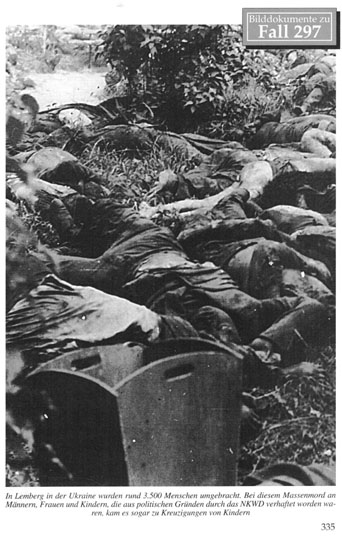
Pictorial documentation to Case 297
About 3,500 people were killed In Lemberg, in the Ukraine. The victims, murder of men, women and children, were arrested by the N.K.V.D. on purely political grounds, and the methods of murder included the crucifixion of children.
Page 336]
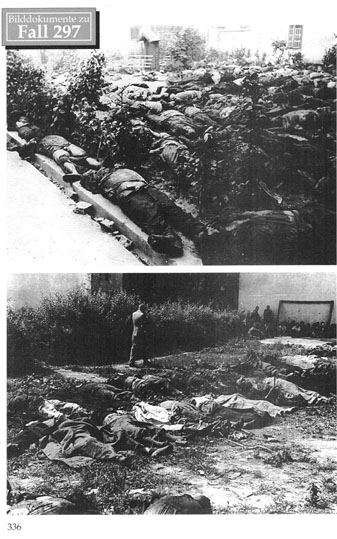
Pictorial documentation to Case 297
Page 337]
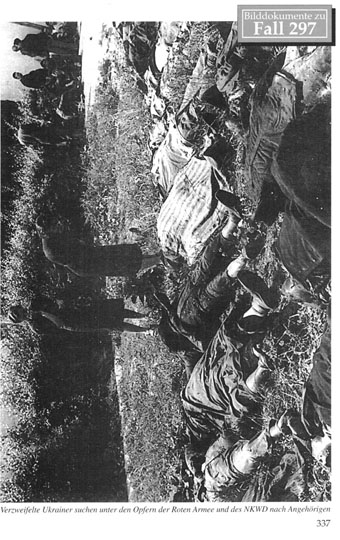
Pictorial documentation to Case 297
Desperate Ukrainians looking for loved ones among the victims of the Red Army and the N.K.V.D..
Page 338]
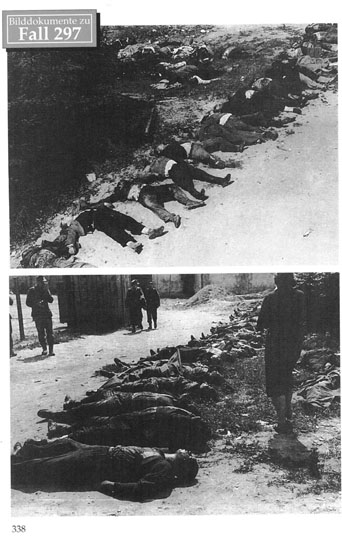
Pictorial documentation to Case 297
Page 339]
"They often hit us with their fists under the chin, so that we fell over backwards, and at the same moment gave us a kick in the genitals. On another occasion three men put us in the middle and beat us in the face with their fists, so that we bounced from one person to another. Each one beat us to the other. Sometimes we had to sit on one foot of a stool, which was placed upside down. Several people suddenly grabbed us, and pushed with all their strength down onto the leg of the stool and thus crammed it into our rectums. We had to stay for hours in a deep knee bend. They found every possible way to torture us. The worst torture took place on 30 May.”
"Shortly after the outbreak of war, seven N.K.V.D. men under the leadership of a prison director appeared in the cell of the witness, named Matla, shouting at the prisoners, 'Lie down, you whores!' At that point they fired several shots. Twelve prisoners were killed and two seriously wounded. The witness escaped being killed because a fatally injured prisoner fell on top of him.
"When the Ukrainians came to look for their arrested relatives in the prisons of Lemberg after the flight of the Russians, they were confronted with a cruel picture of the butchery of helpless people."
The witness Warwara Soziada testifies as follows under oath:
”On Monday, 30 June 1941, I went out early in the morning about four o’clock to the N.K.V.D. prison. I first went to the prison courtyard. I immediately saw several bodies lying around, including three men who had turned completely black, and a woman who was completely naked. The sight was so horrible that I could no longer look. I then looked one more time through a window into the inside of the prison. In the room, I saw a crowd of bodies, slaughtered, lying on a table. The bodies gave the impression as if the victims had been beaten together on the table. A man's body sat in a chair. He had a Russian bayonet driven into his mouth. The hands, and both arms, hung loosely, as if they had been fractured several times. When I looked into another window, I saw the body of a small girl, about eight years old, hanging from the ceiling lamp. The body was undressed. The child had been hanged with a pocket handkerchief. The sight was so horrible that I almost fainted. I had to be taken home by several people.”
The witness Pisarek reported under oath as follows on the N.K.V.D. prison at Lemberg:
“I entered the interior of the prison and looked into the individual cells. It was a terrible sight wherever you looked. The cells were completely filled with the bodies of murdered persons. In one large room, measuring about ten by five meters, the bodies had been thrown on top of each other, up to half a meter high. I got the impression that the victims had been dragged there after being murdered. The location and position of many bodies showed that they had been thrown in there while still alive. You could clearly see from the positions that they had attempted to escape from the pile of bodies.”
The witness Loesch went to the N.K.V.D. prison to look for her arrested mother towards the end of June. She reports under oath:
“I went into the interior of the prison and immediately saw many murdered persons in the first cell, most of whom had also been mutilated. Among others, I saw a woman one of whose breasts had been cut off, the other was torn to pieces. Another woman had had her abdomen slit open; she was pregnant. The head of her child protruded from her abdomen. A male body had had all its teeth knocked out. A small girl was dressed from the waist up, but undressed from the waist down, and completely soaked with blood, especially in the region of the genitals, so that for me there was no doubt that a sexual crime had been committed. In this cell lay about 30 murdered people, including several women. They were all naked. Almost all the bloody places indicated the severest mistreatment. The sight was so horrible that I stopped looking for my mother and left the prison again.”
Page 340]
.
Both the witness Domin and the witness Chruslicki swore under oath that a priest had been crucified on the wall of a cell on the first floor of the N.K.V.D. prison in Lemberg. The witness, Chruslicki, describes his observations in this regard as follows:
“On one of the first days after the liberation of Lemberg, we went to the N.K.V.D. prison. In one cell on the first floor, I saw a priest nailed to the wall. He had been literally crucified. Nails had been driven through the hands and feet, which were crossed. At his foot hung a red cloth with the Russian inscription “Let Christ rescue you!”. I speak Russian and could read the inscription. I recognized this person as a priest because of his tonsure. The body was completely naked. Over the shoulder hung a piece of the cassock. They had cut a cross out of his forehead by skinning it out. When some of the people pushed the body away from the wall a bit, and turned him around, they saw a large cross cut skinned out of his back. The abdomen of the priest had been completely cut open, the intestines protruded, and an unborn child had been thrust into the abdominal cavity -- obviously cut from the body of a woman -- since the same cell contained the body of woman with the abdomen cut open. In the same cell, on the same wall, hung another crucified priest. He could also be recognized by his tonsure. His eye sockets gave me the impression that they were empty. The cell contained many other bodies, some of them horribly mutilated. I saw a woman whose breast had been cut off, another had had the ears torn off. In other bodies, one could that that a strip of skin had been torn off the face, others lay there with broken limbs. In another body I could see that the mouth had been sewn shut with crude twine. I wish to add: I saw that, not just one body but on three. After seeing so many cruelties, I didn’t go any further, but left the prison in disgust. I would like to describe one other incident, which I saw in the same cell: a girl about twelve years old, dressed in her Confirmation dress, had been smashed against the wall with the right hand and left leg. The leg was pulled far upwards in a distorted position. The abdomen was torn open almost up to the breast.”
In one of the orphanages in the Kadecka-Gasse, the witness Chruslicki saw about 30 children’s bodies hanging in a room. These children were between 6 to 15 years old. The children had been hanged with a hook in their mouths. The bodies hung from the wall and ceiling, some of them dressed and some of them naked. One could see that the naked children had been sexually attacked before being hanged.
The female witness Sobonkiewicz reports as follows under oath on her observations In the N.K.V.D. prison:
“On Monday, 30 June, as well as on the following Thursday, I went to the N.K.V.D. prison to look for my girl friend, Olga Baliska, who was arrested three days before the outbreak of the war on political grounds. I even found her body. It was in horrible condition. The back of the head was smashed, so that the brain mass protruded. The right side of the face was blue, the left side covered with blood. The right thigh was completely blue. Next to my girl friend’s body was another female body, blue around the hips and trunk. I had the impression that she had been crushed around the body. The thighs exhibited the same characteristics. Further away lay another female body. This one exhibited signs of burning on the thighs. The left breast was cut off. On the wound was a bandage, obviously fashioned from a torn shirt. The thighs bore the same bandage. We looked for gunshot wounds, but could not find any. Instead, we found an injury to the skullcap, as if she had been struck with a chisel. I also saw a male body with its trousers pulled down. The penis had been cut off. One woman, in an attempt to identify the body, put her hand in the pocket of the coat in which the corpse was dressed, in the hope of finding documents there. She pulled out a small package, wrapped in newspaper.
Page 341]
When she opened the package, it contained the man’s penis. The same body exhibited a deep cutting wound in back of the neck. In the prison cellar, I saw a twelve year old girl, who had been hanged. A butcher’s hook had been driven into her mouth, and she had then been hanged from an iron rod protruding from the wall. The dress on the body was completely drenched in blood. The face was also covered with blood. I saw hundreds of bodies. They all showed signs of torture in varying degrees.”
On 1 July, the witness, Czucha, among other horrible scenes in the N.K.V.D. prison, saw the bodies of two boys, aged eight to fifteen, with their hands tied together. One of them had one leg torn off at the hip, the other, the left arm at the shoulder. Both children’s eye sockets were empty. One child had had the back of the head smashed in; the other boy’s body had long incisions in the back. In the same cell, lay about 90 bodies piled up on top of each other.
Page 342]
Chapter C.2
Atrocities of the Bolsheviks against the Civilian Population in the Baltic
Next to the Ukrainians the residents of the three Baltic Republics, Lithuania, Latvia and Estonia, suffered particularly badly under the prosecutions of the Bolsheviks. The following cases represent only a small excerpt of the cruel events which occurred in the Baltic.
Case 298
On 25 June 1941, a Russian armored car appeared in the Russian concentration camp of Rumschischke (near Kowno), which contained 450 Lithuanians at the time. On order of the driver of the armored car, all inmates in the camp had to go out to the courtyard, including the Lithuanian guards. Machine fire was then opened on all these people. According to the statements of the witness, a Dr. of Medicine from Kowno, about 300 Lithuanians were murdered in this way. The Bolsheviks then threw hand grenades at their victims. In one cell, the body of a man killed by bayonet thrusts was found. Among the murdered people lay a pregnant woman in the ninth month. The Bolsheviks then attempted to blow up the bodies with dynamite, which was not successful.
Case 299
A total of 72 buried bodies of Lithuanians were found in Schaulen on 29 June 1941. The witness, Dr. Bruss, Second Lieutenant (Medical Corps) of a Medical Company, undertook a post-mortem examination. He reports as follows on the findings:
“When I entered the scene of the crime at 10:45 hours, I found an image of inconceivable brutality. There lay 72 male bodies next to each other in many rows. All had their hands tied together behind their backs, with a gag stuck in the mouth. The skin could simply be pulled off: there were strips of skin pulled off the bodies everywhere, sometimes from head to foot,
Page 343]
a certain indication of second degree burns caused by burns or boiling water. The few pieces of clothing, which the bodies still had on were torn and drenched in blood. During the inspection of the bodies, one could see large bruises all over the bodies, caused by blows with cudgels. The shoulder joints were dislocated in some cases. On one hand I found the thumbs torn out, on one scrotum an oedamatous blue colored swelling, to which the penis had been bloodily hacked. The cruelest thing was the completely crushed skulls. All of the 72 bodies were mutilated in the cruelest manner. I saw gouged out eyes, completely deformed lower jaws, broken noses, ears torn off and large defects on the necks. Skullcaps were for the most part crushed. I saw holes twice the size of a fist in skulls, from which the brains protruded. Others exhibited bullet entry wounds the size of a little finger in the region of the forehead with exit wounds the size of a man’s hand in the occipital region, others with bullet entry wounds in the last described place and as exit wounds I found crushing of the region of forehead, i.e. typical shots in the back of the neck. The front parts of the face were swollen and smeared with blood.”
Case 300
According to a report from the Secret Field Police on 22 June 1942, the three Lithuanian priests Balsys, Petrikas and Dabrila were kidnapped from the village by five Russian soldiers in a truck. The bodies were later found in a forest, three kilometers from Bartininkai, robbed and murdered. The bodies exhibited numerous bullet and stab wounds. In the last days before the advance of the German troops in Rositten (Latvia), mass arrests were carried out among the Latvian intelligentsia. After the advance of the German troops, the bodies of 34 Latvians were found mutilated beyond recognition. According to the statements of the witness Pilsums, the skin had been pulled off the hands and the fingernails pulled out of the unhappy victims; the tongues, noses, and ears were also cut off. There were no bullet wounds on the bodies, so it must be assumed that the arrested Latvians had been tortured to death by beating and in other ways.
Case 301
On the Sorve penisula on the Ösel, the bodies of several seriously injured Estonians were found by members of a Heavy Artillery Division during the erection of a command post on 28 September 1941. One body had had the genitals cut off. The victim had obviously bled to death from the wound. Another, rather old, woman was found with a crushed skull. The body of twelve year old boy showed serious injures to the breast, abdomen and back, caused by gun shots and bayonet thrusts. The boy’s breast and back were completely torn to shreds. In one neighboring farmstead, two other bodies were found by German soldiers. One body was completely carbonized, the second body was badly drenched with blood in the region of the genitals. In one bunker the bodies of a rather old woman was found with a fatal injury to the back of the head; the body of an eight-year old child was found who had obviously been killed with bayonet thrusts to the chest.
Page 344]
Chapter D
Cannibalism Among Russian Prisoners of War and on German Dead
From the above described inhumane and ignominious brutalities committed by the Armed Forces of the Soviet Union, it is hardly a step further downwards to cannibalism, which Russian prisoners of war in German collection points proved against each other.
Attached are the records of 11 to 16 November 1941 on cannibalism in Stalag 360, from 28 November, as well as the records on cannibalism in Stalag 357 of 8 to 14 December 1941. The records of 29 November and 6 and 8 December 1941 on cannibalism in Stalag 305 are also attached. The especially horrible cannibal habits in the last named camp is proved by slides of the victims and perpetrators. Case 305 describes a case of cannibalism committed against dead German soldiers.
Case 302
Regarding cases of cannibalism in Stalag (prisoner of war camp) 360, the records are as follows:
Report of the Armed Forces Commanders, Ukraine Local Bivouac, 25 November 1941
Tl. 4/41
To the Commander in Chief of the Armed Forces
-Wehrmacht War Crimes Bureau
Re: Cannibalism in Russian prisoner of war camps.
In annex, we forward the interrogations under oath on cases of cannibalism in Stalag 360, Camps II and III, in Rovno. The cases happened in the time from the end of October to 10 November. The 6 slides enclosed each in duplicate relate to the four cases described in the statements of the witnesses Colonel (Medical Corps) Dr. Kritzler-Kosch and camp physician Dr. Prost (14 and 7th witnesses in the transcript of interrogation, respectively).
Page 345]
Cases of cannibalism continue to occur in Camp III of Stalag 360. Reports are constantly received from other Stalags on the appearance of such cases. The question arises whether these cases should be handled in the same manner as the above, or whether in particular special sworn witness interrogations should be carried out in each case.
In making the abovementioned decision, we request that the often extraordinary difficulties arising from the winter conditions and the problems related to insufficient space should be taken into consideration.
Annex: 15 slides
Signed Allminghoff, Judge Advocate General of the Luftwaffe. Certified: Ministerial Recorder.
Court of the Armed Forces Commanders, Ukraine Local Bivouac, 11 November 1941
Present: 1) Field Judge Advocate Schulte
2) Gefreiter Fiedler as Recording Secretary, obligated according to Sections 104 paragraph 3, paragraph 22, Code of Military Justice.
After discussing the facts of the case with the camp commandant, Specialist Officer Kühn, the following witnesses were interrogated after being informed of the object of the interrogation, being warned to tell the truth and the oath to be sworn, with reference to the significance of the results of perjury or swearing falsely.
"As to my person: My name is Alfred Kühn, 40 years old, commandant of the Russian prisoner of war camp Stalag 360, camp III, Rovno, a farmer in civilian life, married.
"As to the facts: On 30 October 1941, for the first time, the guards reported that bodies of prisoners having died during the night had been found with the fleshy parts of their bodies missing, and this was probably due to a case of cannibalism. I went out with them and found two bodies. These bodies lacked pieces of flesh in the thigh and lower leg. I had the impression that these body parts had been cut out.
"I announced that anyone who ate or dealt in human flesh would be shot.
"The next morning, a few more bodies were found with pieces cut out of them, about 7-8 of them. Also in these cases, there were missing pieces of flesh in the thighs and lower legs; in some cases, the abdominal wall was missing. Ever a few bodies had been really gutted, so that the heart and lungs had been cut out.
"These cases occurred repeatedly in the following nights.
"I made inquiries and found body parts in the mess-tin, coat pockets and bread bags.
"At a few fire places used by the prisoners in preparing their food, we found human flesh in the cooking utensils standing on the fire.
"Most of the prisoners of war declared that they had bought the meat from other prisoners. Some of them claimed to have paid about 250 rubles for a piece of meat the size of a tea saucer.
"These body parts were usually found in barracks housing Asians, especially Usbeks. Body parts were also found among the Ukrainians.
"I myself witnessed the following incident: In viewing the bodies one morning, a prisoner of war, who in my view was an Asian, suddenly went up to the pile of bodies, cut the head off one of the bodies, using a sharpened object of some kind, removed the brain and put it in his cooking pot.
"These cases of cannibalism became more infrequent after the Asian prisoners of war were punished, but isolated cases occurred repeatedly. About every 2 days, new individual cases occurred. The last case was just yesterday, 10 November 1941, in which 2 bodies were found with the heart and lungs missing.
"Whether the prisoners of war killed their fellow prisoners for the purpose of eating them or only cut pieces out of already dead bodies, I do not know. Nothing on the bodies indicated any information one way or another. I did notice, however, that one body bore bluish-red marks of strangulation on the throat. It is furthermore known to me that a guard post entered a barracks on hearing the screams of a prisoner of war during the night, by the light of a flashlight, saw several Asian prisoners of war doing something to a body,
Page 346]
"cutting pieces of flesh out of it. I don’t know the name of the guard. He was assigned from the 1st Company, 302nd Guard Battalion. The guard shot 2 of the Asians on the spot. Because of the others, I had the prisoners of war ordered to deliver up the other guilty men within a certain period of time. Since there was no delivery at the end of this period, I set a new deadline and announced that every tenth man in the set of barracks would be shot if the perpetrator was not turned over by the new deadline. At this point, 7 Asians were brought to us as perpetrators. There were 1,100 men in this set of barracks, mostly Ukrainians. They didn’t dare hand over the Asians at first, and were only compelled to do so by the threat of shooting.
"The Asian prisoners of war included Usbeks, Armenians, Kyrgyz, Turkmenians and Kasachs. It was not possible to discover whether members of all these or only one individual tribe participated in the cannibalism. Nobody confessed. The Ukrainian prisoners of war called the Asians without exception cannibals (they call them the “black people”). During the interrogations, one Usbek declared that they were a nomadic people at home and only lived from meat, which they ate unprepared (raw). He added that it was a shame that good meat was buried here. He meant the flesh of the prisoners of war."
Read out, approved and signed. Signed: A. Kühn
The witness was sworn
2nd witness: Gefreiter Alfred Weigel
“As to my person: Myname is Alred Weigel I am 44 years old, Obergefreiter, Corporal (Supply Corps) with Stalag 360, Rovwo, a locksmith in civilian life, divorced.
”As to the facts: In the period starting on 30 October 1941, in the mornings, I noticed, on several days that pieces of flesh had been cut out of the bodies of prisoners of war who had died during the night. The pieces of flesh involved were removed from the thigh, lower leg, buttock, and parts of the breast and abdominal parts. Individual bodies were even actually disemboweled, in the sense that they were cut open and the heart and lungs were removed. Investigations then established, as I saw myself, that pieces of flesh from the bodies were found the cooking utensils and bread bags and coat pockets of prisoners of war. During our investigations, we also found prisoners in the process of preparing such pieces of flesh from bodies at their fire places. They had stuck these pieces of flesh on sticks and were roasting them over their fires. In two cases, we caught prisoners selling such pieces of roasted flesh to other prisoners.
“The Ukrainian prisoners of war accused the Asian prisoners of being the perpetrators. But pieces of flesh cut from human bodies were also found among the Ukrainians. Whether they cut the flesh out of the bodies themselves or only purchased it, cannot be established. It also happened that Ukrainians resold these pieces of flesh. Whether Ukrainian prisoners of war actually ate flesh cut from human bodies I can’t say. Asian prisoners of war […] and all the Ukrainians upon such flesh was found, were dealt with according to regulations.
“Whether the prisoners of war participating in these acts of cannibalism killed their fellow prisoners for the purpose of eating them, or whether they only cut pieces of flesh out of the bodies of prisoners who had already died, I cannot say. I did not notice any signs on the bodies providing any clues in one direction or the other.”
Read out, approved and signed. Signed: A. Weigel
The witness was sworn.
3rd witness: Karl Rau
“As to my person: my name is Karl Rau, I am 21 years old, I am an interpreter in Stalag 360, Camp III, ethnic German from Saratow in Russia, a farmer in civilian life, married, Lutheran religion.
“As to the facts: Investigations had already commenced due to cases of cannibalism when, one morning about 10 o’clock, a German guard called to me and another interpreter and Gefreiter Weigel, who was interrogated before me, and told us that he had just discovered a case of cannibalism in a set of barracks supervised by himself. We ran into the set of barracks and saw a prisoner of war busy on a body, cutting pieces out of the thigh and lower leg. When he asked him what he was doing, he pointed out all his fellow prisoners who had already cut pieces of flesh from the same body. A search of their mess-tins revealed human flesh. The prisoner of war who had been caught cutting flesh from the body
Page 347]
was an Asian, in my opinion, an Usbek. The other prisoners, as well, upon whom we found human flesh were all Asians, with one exception (a Russian); most of the guilty men, in my opinion, were Usbeks.
“What is more, the next morning, we discovered that, in some cases, pieces of flesh had been cut from the things, lower legs, and buttocks of the bodies. I don’t know whether we found any bodies that had been gutted, i.e. had had the heart and lungs cut out. I only know we found another body one morning, which had been skinned from about breast height downwards. I don’t know what happened to the skin.
“Whether the cannibals slaughtered their fellow prisoners for the purpose of eating them, or only cut the pieces out of prisoners who had already died, I cannot say. In reply to our questions, the prisoners of war always answered that they only cut the pieces out of bodies of prisoners who had already died. I did not notice any indications on the bodies clearly indicating anything in one direction or the other. The bodies were undamaged apart from the incisions. Whether the Asians are cannibals in their own country, I cannot say. Nor can I say the reason why the cases of cannibalism occurred here.
“I have a perfect command of the German language, I am an ethnic German from the Volga region. I have understood each question well and have been able to answer without difficulty.”
Read out, approved and signed. Signed: Rau
The witness was sworn.
[…]
Court of the Werhmachtbefehlhabers, Ukraine Local Bivouac, 12 November 1941
Present: 1) Field Judge Advocate Schulte
2) Gefreiter Fiedler, Recording Secretary obligated under Section 104 III, 22 II Code of Military Justice.
In response to a request, there appeared the next witnesses. They were made familiar with the object of the interrogation and warned to tell the truth, to the consequences of perjury or swearing falsely, and then interrogated as follows:
5th witness: Officer Johannes Winkler
“As to my person: my name is Johannes Winkler, I am 42 years old, Corporal, 1/Ld.Schtz. Batl. 303, a weaver in civilian life, married.
“As to the facts: I am assigned to Stalag 360, Camp III, in Rovno from time to time. On 8 November 1941, a member of the local Ukrainian guard personnel came to me and asked me to go with him to a set of POW barracks, with a pile of bodies in front of it. The bodies had been carried out of this set of barracks that morning. A Ukrainian showed me several bodies missing pieces of flesh, cut from the lower leg and thigh. The sight was so disgusting that I didn’t look any closer. I didn’t see any other injuries on the bodies. So I can’t say whether the prisoners of war killed their fellow prisoners for the purpose of eating them of only cut pieces of flesh from bodies of people who had already died. I didn’t about other aspects of this matter, such as whether European Russians or only Asians dedicated themselves to cannibalism and what reasons might have driven the prisoners of war to cannibalism, and I don’t know the answers.
“I was on guard duty in Camp II of Stalag 360 from time to time. On 4 or 5 November 1941, a Russian medic showed me the body of a prisoner of war which was also missing pieces of flesh from the lower legs and thighs. I didn’t see any other incisions on the body. I do, however, remember that there was blood on the forehead of the body. I didn’t see whether the skull had a hole in it or had any other kind of injury; nor did I concern myself with these matters. In this case as well, I don’t know why the cannibalism occurred. Nor do I know whether the cannibals killed the prisoners of war beforehand, or only cut pieces out of already dead bodies.”
Read out, approved and signed. Signed Officer Winkler
The witness was sworn.
Page 348]
In response to an order Second Lieutenant (Medical Corps), Dr. Josef Prost appeared and was interrogated as follows before being sworn.
7th witness: Dr. Josef Prost
“As to my person: My name is Josef Prost I am an Second Lieutenant (Medical Corps) and camp physician at Stalag 360 in Rowno, 33 years old, a general practitioner of medicine in civilian life, married.
“As to the facts: As camp physician, I received the report about 14 days ago that in Camp III, Stalag 360, four bodies of prisoners of war had been found from whose bodies pieces of flesh had been removed, and some of whom had been actually gutted. On the spot, I found the 4 bodies referred to. 3 of the bodies were missing pieces from the lower leg and thigh, as well as from the buttocks; the fourth body was just the same, but, in addition, the thoracic cavity had been opened, and the heart, lungs and liver were missing. Near the bodies lay cooking pots, partly filled with brains. I made the following observations, which I now dictate in accordance with my notes made at the time:
“4 bodies:
“Cooking pots with remains of food (flesh, brain).
“In the following time, even up the last few days, individual cases of cannibalism were reported to me repeatedly. Overall, 20 cases of cannibalism must have been reported to me in Stalag 360. Inspection of the bodies revealed similar phenomena, as I had observed the first time.
“Whether the prisoners of war killed their follow prisoners for the purpose of cannibalism or only cut pieces of flesh out of the bodies of prisoners who had already died I cannot say. I saw no clear marks on the bodies providing any unambiguous information in this regard. My personal view, however, is that the cannibals killed their comrades when they were already exhausted by hunger, in order to eat to eat them. As stated, I do not any actual evidence for this point of view. As far as I know, the designated perpetrators were mostly members of Asian tribes, particularly Usbeks. These tribes consist of the following ethnic groups: Usbeks, Asmans, and Kasachs. When we interrogated the Usbeks, they claimed it wasn’t them that slaughtered people in their home country, instead, only the Kasachs did this.
“There were no religious aspects to the cases of cannibalism in Stalag 360, nor were these in any way ritual murders. Instead, I attribute these cases to hunger -- particularly, hunger for meat – on the part of precisely these Asian tribes. I happen to know that these Asian tribes nomadic tribes, in their countries, live partially off raw meat. I therefore assume that, in view of the complete lack of meat in the camp, they could not summon up the necessary inhibitions against participation in cannibalism against their fellow prisoners.
“Another reason for saying there were no ritual motives for these cases of cannibalism, cannibalism, particularly, disembowelment of the bodies by removal of the breast and abdominal inner organs, was because, as already reported to me, there was also a trade in human flesh among the prisoners of war.”
Read out, approved and signed. Signed Dr. Prost
The witness was sworn.
In reference to the oath already sworn, the witness furthermore declared as follows:
”I never saw any members of any Asian nomadic tribes among the bodies examined. This reason alone shows in my view, that these crimes can only have been committed by members of Asiatic tribes.”
[…]
Read out, approved and signed. Signed Dr. Prost
Page 349]
Present: 1) Field Judge Advocate Schulte
2) Specialist Officer Lebedeff, acting interpreter
After consultation regarding the subject matter with the camp commandant, Specialist Officer Lebedeff, the following witnesses appeared in response to an order. They were familiarized with the object of the interrogation and advised of their impending oath, warned to tell the truth and then interrogated as follows:
9th witness: Leonti Kapanadze, field hospital physician.
“As to my person: My name is Leonti Kapanadze, I am a Russian Military physician (Kriegsarzt III rank). In civilian life, I am Second Lieutenant (Medical Corps) with the hospital in Charkow, I am 29 years old, Dr. of surgury, married.
“As to the facts: I a Russian field hospital physician in Stalag 360, Camp II. On 6 November 1941, as on every other day, I searched the prisoners’ barracks for bodies of prisoners having died during the night. While I was doing so, I passed the cellar of a building which also housed some prisoners of war, and found the body of a Russian prisoner of war. It was not the body of a Asian. I entered the building and noticed that pieces of flesh had been cut out of the body. Pieces were missing from the thigh and lower leg as well as the buttocks. I could not observe, however, any marks of strangulation. On the other hand, the body exhibited two rather long holes in the skullcap in the region of the temporal bone. The skullcap was smashed at these places in other words. I enclose a drawing I made in this regard for your archives. The head of the body lay on its left side. The head was covered with blood. The holes in the skullcap indicate that they were inflicted with a longitudinal blunt object, like an iron bar.
“I immediately reported this find to the camp administration. Finally the lodgings of the prisoners of war were searched for pieces of flesh, but nothing was found. In my opinion, the death had occurred about 24 hours previously.
“Judging by the position of the body, I assume that the prisoner of war was killed in order to be eaten. At the same time I do not particularly believe that the perpetrator or perpetrators ate the flesh themselves. Instead, I assume that the perpetrator, or perpetrators, killed the prisoner to sell the flesh. They don’t need to kill prisoners of war out of hunger since the camp food rations are sufficient to protect the prisoners of war from hunger. Members of Asian ethnic tribes, however, have such a craving for meat that they cannot be satisfied with the camp food. In exploiting this circumstance, in my view, the perpetrator, or perpetrators, killed the prisoner in order to sell the flesh to fellow prisoners with a similar craving for meat, perhaps without mentioning the fact that it was human flesh. The sale of meat and other food is, of course, possible since the prisoners of war are still in possession of money.
“From my own personal knowledge, I know that Asian ethnic tribes do not engage in cannibalism in their own countries. I am a Grusiner myself (born in Tiflis), and I am familiar, among others, with the Gusiners, in addition to Armenians and Tatars. I can say that cannibalism does not occur among these 3 ethnic tribes. Nor have I have that other tribal groups commit cannibalism, in particular, I have never even heard this of the Usbeks and Asmans. I therefore know nothing about whether religious or ritual motives play a role in this regard. It is true that members of Asian tribes have a great craving for meat, which they usually explain by the fact that they are mostly nomadic peoples and live from their livestock herds. I have never heard that these tribes, for example, eat raw meat -- rather, that they prepare the meat before eating it. The Tatars abhor even pork; on the other hand, the Usbeks and Asmans prefer fatty meat in particular.
“Cases other than the above describe are unknown in Camp II.
“I have heard of cases in Camp III, and I also know that human flesh is said to have been bought and sold there. This is based on my above mentioned assumption that the prisoners of war were murdered to be able to sell flesh from the bodies.
“Moreover, I would like to remark that cases of cannibalism occurred in the winter of 1932/33, during the occasion of a famine in the Ukraine. Many villages were abandoned by their inhabitants and that some of the bodies left behind had had obviously been partially eaten, or that pieces had obviously been cut out of them. I studied right in Odessa at the time, and these things were well known there.
Page 350]

Pictorial documentation to Case 302
Bodies of prisoners of war from whom pieces of flesh had been for eating
Page 351]
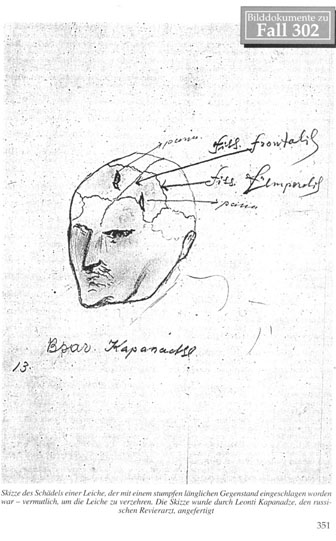
Pictorial documentation to Case 302
Sketch of the skull of a body, the skull of which had been smashed in with a longitudinal object – presumably in order to eat the body. The sketch was prepared by Leonti Kananadze, the Russian field hospital physician.
Page 352]
“My explanation that the camp portions were sufficient to protect the inmates from hunger is not contradicted by fact that prisoners of war died from exhaustion in the camp every day. They didn’t die from insufficient rations, but rather, because they were transported to the camps in a completely undernourished condition, and had no resistance. You have to remember that the age groups making up the greatest proportion of the prisoners of war were born in 1918-21, i.e. years during which famine prevailed all over the country, as a result of the collapse of the Czarist regime and the Soviet revolution. Men from these age groups therefore had less resistance from birth onwards. Even the sight of the completely emaciated bodies, which only consisted of skin, bones and sinews, shows without any further need for demonstration, that this condition cannot have been caused by the stay in the camp, since the prisoners had only been here for a month, and could not have been reduced to this completely famished condition in this period of time, even if the rations had been scarce.”
"The transcription of my interrogation has been read out to me and then translated word for word by the interpreter. I have understood everything, word for word."
Read out, approved and signed. Signed: Kapanadze
The witness was sworn.
10th witness: Iwan Petrischenko.
“As to my person: My name is Iwan Petrischenko, 23 years old, medic on active service with the Soviet army, unmarried.
“As to the facts: On the day the bodies were found, I, together with the field hospital physician, the last witness interrogated searched the POW barracks for bodies, and, on this occasion, together with the field hospital physician, found the bodies with pieces of flesh cut out of them. The bodies were missing pieces of flesh in the thigh and lower leg, as well as from the buttocks. Furthermore beneath the ribs straight down the abdomen a cut had been made. The body was not disemboweled. The head of the body exhibited two holes in the skullcap. The head of the body was stained with blood. I did not notice whether the holes broke through the skullcap.
“I had the impression that the prisoners of war were killed by their fellow prisoners. Whether this was done to eat or sell flesh from the bodies, I do not know. Whether or not the perpetrators themselves ate these body parts, I cannot say. All subsequent investigations were unsuccessful. I assume that the perpetrator or perpetrators need not necessarily need have eaten the flesh themselves. Rather, it is possible that they sold it to other prisoners without eating any of it themselves, and, of course, in selling it, they need not have said that it was human flesh. It is possible that the perpetrators were members of Asian tribes, since they trade upon every occasion in any possible kind of merchandise. They even sell their own daily food rations. It is also known to me that trading in human flesh had been discovered in Camp III cases of. I would furthermore like to note that the victims did not include one single Asian: they were all Europeans.
“I do not know from personal observation whether cannibalism occurs among Asian tribes. I myself am Ukrainian from Uman. In school, however, they told us that a few Asian tribes of the Soviet Union have very low levels of culture and ate people.
“It is correct that cases of cannibalism occurred even in the Ukraine in the famine winter of 1932/33. At that time, it was well known, and appeared in the newspapers, that there was a booming trade in human flesh. It is very improbable that that those who knew that it was human flesh would have eaten any of it themselves. Rather, these people brought the flesh into the trade and sold it to ignorant people who thought they were buying animal meat. To this end, the flesh was not sold raw, but was prepared, especially as meat in gelee, in aspic, in jellies, etc. Among the camp population, the rumor was going around that Jews were especially dedicated to this trade in human flesh, in full awareness of the fact that this was not animal flesh, but human flesh.
“The Jews were not accused either of killing people to sell their flesh or to cut pieces from their flesh. We were not told at school that the alleged cases of cannibalism among Asian tribes were attributable to ritual or religious motives.
“I do not believe that the one case of cannibalism in Camp II was due to hunger. The cause assumed by myself has already been indicated by myself.
Page 353]
“It is correct that prisoners of war die of undernourishment in the camp every day. But that is not due to insufficient camp rations, but to the following circumstances: one, the prisoners already arrived at the camp completely undernourished, and two the people are so dirty and filthy, that their health must necessarily suffer. The camp food is not enough to keep people alive under such unfortunate circumstances due to the person of the prisoners of war. It would be completely sufficient if these were ordinarily nourished people.
The transcript of my interrogation has been read out to me and than translated sentence by sentence by the interpreter, the camp commandant, I have understood everything perfectly and it is correct.”
Read out, approved and signed. Signed: Petritschenko
The witness was sworn.
Signed: Johann Lebedeff, Camp Commandant, Interpreter. Signed: Schule, Field Judge Advocate.
Signed: Gefreiter Fielder. Recording Secretary. Certified: Ministerial Registrar.
[…]
Court of the Wehmachtsbefehlshaber Ukraine OU 16 November 1941
Present: 1) Field Judge Advocate General Schulte
2) Gefreiter Fiedler, Recording Secretary, obligated under sections 104 paragraphs 3 and 22 of the 2 Code of Military Justice
In response to an order the following witnesses appeared. They were familiarized with the object of the interrogation, warned to tell the truth, advised of the significance of the oath to be sworn and of the consequences of perjury or swearing falsely.
12th witness: Gefreiter Otto Zühlke
“As to my person: my name is Otto Zühlke, I am 42 years old, I am a Gefreiter in the 1st company, 330rd Local Defense Battalion, a master tailor in civilian life, married.
“As to the facts: I am assigned to Camp III of Stalag 360 as guards. In the first week of November, i.e, starting on 3 November 1941, when I went on guard duty, at around 23 hours, I noticed that the body of a POW which I had seen lying before a set of barracks when I went off duty about 4 hours earlier had disappeared. I went into the set of barracks and surprised a prisoner of war in the entrance hall of the set of barracks doing something to the corpse. He had already cut several pieces of flesh out of the thighs and was just about to open the thoracic cavity. He had the sleeves rolled up to the elbows, the hands were covered with blood up to the wrist joint. With the bloody knife he held in his hands, he looked like a butcher. In accordance with orders, I shot him on the spot.
“A few days later, I noticed during a round, that a few prisoners were preparing something in their cooking utensils on the fire. I called to one of them and ordered him to come to me with the cooking utensils. Since I had heard that prisoners of war prepared human flesh for themselves. He came to me and hold his cooking utensils over my head so that I couldn’t see into it, at the same time objecting that he only had water in it. I knocked the cooking utensils out of his hand so that the content poured out on to the ground. It turned out that the cooking utensils, in addition to water, contained pieces of flesh, diced into pieces, like goulasch. The pieces of flesh looked like lean pieces of pork. Since the prisoners have so possibility to acquire meat products, I assume that this was human flesh, in addition to the fact that the prisoner had made an effort to deprive of an insight into the cooking utensils. When I attempted to arrest him, he escaped into the darkness.”
Read out, approved and signed. Signed: Gefreiter Zühlke
The witness was sworn.
In relation to his oath as witness, the witness furthermore declared as follows:
“I cannot say exactly whether the body and the perpetrator in the first case about which I have been interrogated, was a (European) Russian or Asian. I might like however based on the memory which I still have of the appearance of the body as well as that of the perpetrator, that these were not Asian, but rather European Russians. I was unable to make further observations on cases of cannibalism.”
Read out, approved and signed, Signed Gefreiter Zühlke
Page 354]
Court of the Armed Forces Commanders, Ukraine Local Bivouac, 16 November 1941
Present: Field Judge Advocate General Schulte (without Recording Secretary)
The following witnesses were interrogated as follows after being advised that they would be sworn.
14th witness: First Lieutenant (Medical Corps) Dr. Kritzler-Kosch.
“As to my person: My name is Hans Kritzler-Kosch, 53 years old, Lieutenant Colonel (Medical Corps),
executive medical officer with the Armed Forces Commanders, Ukraine, married.
“As to the facts: On 1 November 1941, at the order of the Quartermaster General at the Armed Forces Commanders (fh) [?], Ukraine, Lieutenant Colonel of the General Staff, Sichting, dated 31 October 1941, I performed a medical examination, in the presence of my medical orderly for special deployment [z.b.V.] Major General (Medical Corps) Dr.Holland and camp physician, Second Lieutenant (Medical Corps) Dr. Prost, of the bodies of four Soviet POWS reported to have fallen victim to the cannibalism at the hands of other Soviet POWs from Usbekstan.
“During the examination, I photographed the four bodies, as did Assistant Physician Dr. Prost. The taking of photographs was made more difficult by the cloudy weather, rain and snowfall prevailing at the time.
“Results:
“The bodies, those of 4 naked, seriously emaciated males, were collected for later burial at a location in the (next to the scrap materials dump).
“Body 1: both thighs were entirely exposed from their musculature, so that the femurs were completely visible.
“Body 2: The abdominal cavity had been opened by a longitudinal incision. The abdominal cavity and thoracic cavity had had all viscera (lungs, heart, diaphragm, liver, spleen, kidneys and intestines) removed. Next to the head lay the lid of a cooking pot with half a human cerebrum, which must have belonged to a fifth body, other than those available, since the skulls of the 4 bodies were undamaged.
“Body 3: The region of the buttocks had had considerable parts of the fleshy muscular mass removed.
“Body 4: Pieces of muscle were missing from the front right thigh in the region from the groin to the lower third of the calf.
“On all 4 bodies there were no other injuries such as stab wounds, marks of strangulation or the like.
”Expert opinion:
“The body parts taken related only to those body parts suitable for eating (mass of larger muscles, abdominal glands, intestines).
“Whether the POWs examined died a natural death before being robbed of their flesh and viscera, or whether the removal of the missing parts only occurred after a natural death had already occurred, could not be decided due to lack of corresponding murder wounds.
“It cannot excluded, even if it cannot be proven at a later time, that the removal of certain parts was very probability intended for eating was committed against defenseless men who were still alive, but near death, and were slaughtered while they were still alive, thus causing death.”
Read out, approved and signed. Signed: Dr. Kritzler-Kosch, Colonel (Medical Corps)
The witness was then sworn.
Signed Schulte, Field Judge Advocate, Certified: Ministerial Recorder
Case 303
A long series of cases of cannibalism also occurred in the camp of Szepetowka. For the most part, this occurred on the bodies of persons who had already died but, in individual cases, prisoners were killed for the purpose of being eaten.
Page 355]
Documents to Case 303
Court of the Armed Forces Commanders, Ukraine Local Bivouac, 14 December 1941
To the Commander in Chief of the Armed Forces
Wehrmacht War Crimes Bureau, Berlin W 35, Tirpitzufer 72-76
Subject: Cannibalism
Extract: StL 33/41, order dated 3 November, 1941, reference f 28 WR (U) U 1210/41
Appended: 5 documents
In annex to the above stated matter, we enclose the original documents of the transcripts on the interrogation of 4 guards and 10 Russian POWs on the cases of cannibalism having occurred in Stalag 357 in Szepetowka.
It should be noted that, in addition to the mentioned findings in the above mentioned camp, in about 100 cases, bodies were found in which pieces of flesh had been cut out of them, particularly from the legs, arms and breast. In addition, in about 8 to 9 cases, bodies were observed in which all the flesh, including the interior organs, had been incised or cut out or scraped out, right down to the skeleton. In the majority of cases, this happened to bodies of the dead. Only in individual cases did the Russians kill their fellow prisoners. A complete establishment of fact in this regard could only be made in two cases (see the interrogation of Feldwebel Rosenthal). On the other hand, the number of prisoners of war guilty of cutting flesh from the bodies of already dead or freshly killed fellow prisoners during the time period from mid-September to mid-October 1941, amounts, by conservative estimate, to 400 to 500.
Originally, it was chiefly Asians and Caucasians who ate the flesh of their fellow prisoners. This circumstance, and the fact that, among these people, the Usbeks formed the greatest group proportionally, led to the conclusion that the cannibalism was generally due to the Usbeks. During the review of the cases occurring in Stalag 357, it was almost always found that almost all the peoples in the camp representative of the Russian nationalities, in particular, the Russians as well, as well as the Ukrainians, cut out flesh from the bodies of the dead or killed fellow inmates or traded in it, and ate it boiled or roasted condition. The least often participating were the Tatars and the strongly Mohammedan Caucasians.
On behalf of: Signed Dr. Petzke, Judge Advocate, Certified: Secretary.
Court of the Armed Forces Commanderss Ukraine Szepetowka, 28 November 1941
Present: Field Judge Advocate Dr. Petzke
Gefreiter Gefreiter Fiedler, Recording Secretary, obligated according to Section 104, paragraphs 3, 22, and paragraph 2 of the Code of Military Justice.
For the purpose of investigation of the cases of cannibalism having occurred in Stalag 357 in Shitomir, the above mentioned signed persons travelled to Szepetowka on 27 November 1941, some of them by truck, some by rail. There the following witnesses were interrogated in the kommand post of Stalag 357 on today’s date.
Officer Kintzi was assigned as interpreter to the court of the Armed Forces Commanders, Ukraine.
He declared that he was familiar with the significance of the oath:
“My name is Kintzi, Gustav, I am a Corporal, 20 years old, now with the court of the Armed Forces Commanders, Ukraine.”
He was thereupon sworn as interpreter.
In response to an order, the 1st witness, Koroba, appeared. The witness declared as follows after being informed of the significance of the oath.
“As to my person: my name is Korobka, Matwej Semjonowitsch, I am 33 years old, a physician (psychiatrist), Russian, was called to the colors for only 10 days and was only active as a physician for two days, at the present time head of the field hospital in the Ostrog auxiliary prisoner of war camp.
As to the facts: On 24 September 1941, I was taken prisoner at Borispol; after being held in other camps I first came to the Szepetowka prisoner of war camp, later the Ostrog camp, in which I am head of the field hospital. I can no longer say when I was assigned to Ostrog.
“A rather long time ago, it must have been beginning of November 1941, a Russian medic came to me and reported that he had established that a piece of flesh had been cut from the thigh of a body
Page 356]
“I established the truth of this report, and reported my findings to the camp administration. I ordered my personnel to watch the bodies carefully, and to report any desecration to me. I had talks with my fellow prisoners to the effect that it was unworthy of Russians to eat human flesh. My fellow prisoners then declared themselves ready to name the guilty party to me. The Ukrainian veterinary researcher Bondarenko and fellow prisoner Manko were found to be those parties. Manko indicated that he had only cut the piece of flesh out of the body’s thigh at the urging of Bondarenko.
“Bondarenko did not tell me personally that he had the human flesh obtained for him ‘because it might come in handy’.
“I did not personally see that the flesh had been cut out of the right thigh, a Second Lieutenant (Medical Corps) in the field hospital saw it. The crime was committed on a corpse, not on a human being who had killed first, as reported to me by the doctor.
“The fact is incomprehensible to me because all prisoners received warm food twice daily, and are therefore sufficiently well fed. Manko replied under interrogation that even he had been sufficiently well fed on the date of the crime.
“It is my view that Bondarenko and Manko obtained the flesh mainly to be able to sell it. Prisoners have told me that he offered them the human flesh for 50 rubels or for underclothing.”
"The above record was read out to me in the Russian language by the interpreter, approved by the witness and signed by him as follows":
Signed: M. Korobka
The witness was sworn.
Signed Dr. Petkze, Field Judge Advocate, signed Gefreiter Fiedler.
[…]
In response to an order, the 3rd witness appeared, and declared that he was familiar with the significance of the oath.
“As to my person: my name is Fomin, Wassil Iwanovitsch, I am 29 years old, a tractor driver by profession, Ukrainian, a soldier with the 10th Infantry Regiment since 23 June 1941, a prisoner since July 1941.
“As to the facts: I am the third month of my imprisonment in the forest camp of Szepetowka. I now belong to the Ukrainian auxiliary guard crew, and as such, I act as assistant policeman in the forest camp. Before, I was only active as prisoner camp policeman. Among other things, Feldwebel Rosenthal ordered me to watch the prisoners and see whether they stole any human flesh. With two other comrades, I once stood behind the door in this camp and in so doing, (it was on the second floor) I saw two Usbeks doing something to a dead body. The body was naked. They turned it over and around. Finally, they cut into the thigh with an ordinary knife. One of them even cut a piece out of it and stuck it on a piece of wood. We immediately entered the room, arrested the prisoner and handed him over to the camp commandants.
“I did not see any other cases.
“This event happened during the first month of my present captivity here.”
The above transcript was read out to the witness by the interpreter in the Russian language, approved by the witness and signed by him as follows.
Signed: Wassil, Fomin
The witness was sworn.
Signed: Dr. Petzke, Field Judge Advocate. Signed: Gefreiter Fiedler
[…]
In response to an order, the 5th witness, Martschenko, appeared, and declared as follows after being familiarized with the significance of the oath:
“As to my person: my name is Martschenko, Hrihori, I am 29 years old, a farmer by profession, Ukrainian, a soldier since 23 June 1941 with the 10th Infantry Regiment in Bjelaja Zerkow, in captivity since 13 July. My last rank was that of Sergeant.
“As to the facts: About 10 days after being taken prisoner, I was transferred to the prisoner of war camp in Szepetowka. I was first an assistant medic, I am now a member of the Ukrainian guard personnel and a camp policeman. Some time ago, I can no longer give a more exact date,
Page 357]
"I saw a fellow prisoner cutting pieces of flesh from the thigh of a corpse using a knife. Whether the prisoner was killed for this purpose or had already died, I cannot say. The fellow prisoner stuck the cut out piece of flesh onto a piece of wood and held it in the flame of a iron stove in the common room. This sight disgusted me. I immediately left the common room and told German soldiers of my observers, who arrested this prisoner and 2 others who were also supposed to have eaten human flesh. These prisoners were Nasmenians.”
The above transcript was read to the witness by the interpreter in the Russian language, approved by the witness and signed as follows.
Signed: Martschenko Hrihori
The witness was sworn.
Signed: Dr. Petzke, Field Judge Advocate. Signed: Gefreiter Fiedler
[…]
In response to an order the 7th witness, Gotscherga, appeared and declared as follows after being familiarized with the significance of the oath.
“As to my person: my name is Gotscherga, Alexei Pawlowitsch, I am 22 years old, a worker in a shoe factory by profession, Ukrainian, a soldier since the end of 1939 with the 203rd Artillery Regiment in Odessa, a prisoner of war since 7 July 1941.
“As to the facts:
“I am a member of the Ukrainian auxiliary guard personnel. Before I belonged to the Ukrainian auxiliary guard crew, I observed prisoners of war roasting flesh in the oven of their barracks. I asked them, since I knew there was no meat in the prisoner of war camp, where they got the flesh. In response it was called out to me by other prisoners of war (Ukrainians) who were in the back of the room, that it was human flesh. I then took these two prisoners to the commandant.
“Both were Usbeks, who did not themselves admit to cooking human flesh.
“On the interrogation: When I asked the prisoners where they got the meat, other prisoners, also from the background of the other prisoners, called out to me, ‘if you want some, cut some off, there are dead bodies outside’.
The above transcript was read out to the witness in the Russian language, approved by the witness and signed by him, as stated below.
Signed: Gotscherga Alexei Pawlowitsch
The witness was sworn as witness.
Signed: Dr. Petzke, Field Judge Advocate. Signed: Gefreiter Fiedler
[…]
In response to an order the 9th witness, Bondarew, appeared and declared as follows after being familiarized with the significance of the oath:
“As to my person: my name is Bondarew, Alexei Iwan, I am 20 years old, a cabinet maker by trade, Russian, a soldier since 15 September 1940 with the 204th Parachute Brigade in Borispol, assigned as infantry man, a member of the guard in an airplane factory, in captivity since 11 July 1941.
“As to the facts: Since September 1941, I have been assigned to the Szeptowka POW forestry camp. I am a medic in the field hospital of the forest camp and as such have the task of burying the dead. Among the bodies I buried at the end of September 1941, were about 8 or 9 whose flesh the inner organs of which had been removed. From these bodies only the head and the bones remained. In addition, I saw about 100 bodies from whom pieces of flesh had been cut, especially from the legs, arms and breast. On the other hand, I did not see that any inner organs had been taken from these bodies.”
The above transcript was read out to the witness in the Russian language, approved by the witness and signed by him as follows.
Signed: Bondarew Alexei Iwan
The witness was sworn
Signed Dr. Petkze. Field Judge Advocate. Signed: Gefreiter Fiedler
In response to an order the 10th witness, Sapelowow, appeared and declared as follows after being familiarized with the significance of the oath:
“As to my person: my name is Sapelowow, Jakob Wladimirowitsch, I am 25 years old, a worker by profession
Page 358]
“I was a soldier from 1936 to 1938, a soldier again from 28 June 1941 with the 476th Telegraph Battalion, a prisoner of war since 8 August 1941.
“As to the facts: Since mid-September 1941, I have been held in the Szepetowka camp. As camp policeman, I was commandant over all the Russians, who were in the field hospital. Some time after my transfer to the present prisoner of war camp I observed with my own eyes how 8 POWs cutting pieces of flesh out of a corpse with a home-made knife made of sheet metal, especially from the thighs, in addition to the ears and nose. These pieces of flesh had already been cut out of a second body lying nearby. They had stuck these pieces onto a stick of wood and were roasting it on the fire. One POW only had pieces of flesh in his cooking utensils. I also saw other mutilated bodies lying around from whom pieces of flesh had been cut. I did not see any bodies from whom the inner organs had been removed.”
The above transcript was read out to the witness in the Russian language, approved by him and signed as follows.
Signed: Sapelowow
Signed: Dr. Petzke, Field Judge Advocate. Signed: Gefreiter Fiedler, Certified: Secretary.
Court of the 811th Field Command Post Shitomir, 8 December 1941
Reserve Auxiliary List no. 35/41
Present: 1. Dr. Uhlig, Judge Advocate
For the purpose of investigating the cases of cannibalism in Stalag 357 among the POWs housed there, there appeared today at the agency Rifleman Erich Kuntzsch of the 3rd Company, 351st Local Defense Battalion, and was interrogated as a witness as follows, after being familiarized with the significance of the oath:
“As to the facts: my Company, had to do guard duty in Stalag 357 in September 1941 in Szepetowka. Still in the first half of September, I was assigned one night as two-man guard duty in front of a set of barracks in the Stalag, where Russian POWs were housed. My comrade on guard duty was Gefreiter Bruno Heil, from my Company.
“Between 1 and 3 in the morning, we heard a horrible scream from the barracks. According to our instructions we were not permitted to enter the barracks. We went as close as we were permitted to do so. A prisoner assigned as assistant policeman with a white armband gestured to us, by means of dramatic gestures, that a crime was just being committed. We looked through a window into the ground floor, into a large room full of prisoners sitting around a fire upon which they were roasting meat stuck on sticks of wood. We had heard a few days before that the bodies of POWs had been cut up. I myself saw the body of a prisoner whose buttocks had been completely exposed, down to the backbone. You could see the bones of the backbone, you could see that the flesh had been cut off by slicing. Heil and myself told each other that this was another case of cannibalism. With the help of the assistant policeman, we had the seven guilty parties brought out through the window, and took them away. One of these men had a bag with him. We both noted that he had a liver and a heart and pieces of flesh in it. There was also some human skin. From illustrations I am aware of the shape and size of a human liver and a human heart. The liver and heart in the bag were certainly of human origin. We reported the case upon being relieved of duty around 3 hours. What happened after that, I do not know from my own experience. The hands and faces of the arrested persons were smeared with blood.
“The next morning I was off duty but I was present when the Russian barracks was searched and several desecrated bodies of POWs were brought out. They were all completely naked. On one of the bodes, a flat piece of flesh the size of a human hand had been cut out of the buttocks, another body had had the abdomen sliced open, the intestines hung out and the thoracic cavity was empty.”
Read out, approved by the witness and signed, Signed Erich Kuntzsch, Rifleman
The witness was sworn. Signed Dr. Uhlig, Signed Officer Ullrich, Certified: Secretary.
Page 359]
Court of the 811th Field Command Post Shitomir, 8 December 1941
Reserve Auxiliary List no. 35/41
Present:
1. Dr. Uhlig, Judge Advocate
2. Officer Ullrich, Recording Secretary, obligated under Section 104 paragraph 3 and Section 22 paragraph 2 Code of Military Justice.
For the purpose of investigating the cases of cannibalism having occurred among the POWs housed in Stalag 357, Rifleman Emil Rudolf of the 3rd Company, 351st Local Defense Troop Battalion appeared and was interrogated as follows after being familiarized with the significance of the oath.
“As to my person: My name is Emil Gustav Rudolf, I was born on 10 May 1905 in Reichenberg, Sudetengau, I am a factory worker in Katherinenberg bei Reichenberg Sud, I have been a soldier since 29 May 1941. I have been with the 3rd Company, 351st Local Defense Troop Battalion since 8 July 1941.
“As to the facts: I was assigned to guard duty at Szepetowka in Stalag 357 at the beginning of September 1941. As guard I had to guard the wire cage where POWs were still housed in an improvised manner while it was still warm About two or three days after my entry on duty I found one morning about 7 o’clock as I came on guard duty, a few naked bodies next to the wire cage, from which pieces of flesh the size of a man’s hand had been cut from the knees, calf and buttocks. While I was on duty, a body was brought out of a POWs quarters. Apart from the head, hands and a few pieces of flesh, only the bloody skeleton remained. When I appeared, a few pieces of flesh lay in front of the wire cage. The guard whom I relieved told me that these pieces of flesh had been taken away from the prisoners in the wire cage. A camp policeman (a prisoner used as an assistant policeman) told me that a prisoner housed in the cage had been found with a large piece of flesh in his pants pocket. This piece of flesh could only come from bodies, since the prisoners received no meat in their rations at that time.
“The bodies found when I came on duty were brought out from the Russian POW barracks. The guard whom I relieved told me that.”
Read out, approved by the witness and signed. Signed: Emil Rudolf, Rifleman
The witness was sworn. Signed: Dr. Uhlig. Signed: Officer Ullrich. Certified: Secretary.
Court of the 811th Command Post Shitomir, 8 December 1941
Reserve Auxiliary List no. 35/41
Present: 1. Dr. Uhlig, Judge Advocate
2. Officer Ullrich, Recording Secretary, obligated under Sections 104 paragraph 3 and Section 22 paragraph 2 of the Code of Military Justice.
For the purpose of investigating the cases of cannibalism having occurred among the POWs housed in Stalag 357, Rifleman Amsel, of the 3rd Company, 351st Local Defense Troop Battalion, appeared and was interrogated as follows after being familiarized with the significance of the oath.
“As to my person: my name is Hermann Paul Amsel, I was born on 6 July 1941 in Ludwigsdorf Kreis Goldberg, Silesia, I am agricultural assistant by trade, last in Jesau bei Kamenz in Saxony, I have been a soldier since 16 December 1941, with the 3rd Company, 351st Local Defense Troop Battalion since 9 July 1941.
“As to the facts: In September 1941, my Company, was on guard duty in Stalag 357 Szepetowka. At the beginning of September about 5 or 6 in the morning I was on duty guarding a set of barracks full of POWs of Russian nationality. From a room on the ground floor, I heard cries for help. I looked inside and saw about six Russian POWs struggling with each other. Four of them held two tight and dragged them to me at the window. One of the four pressed a die-shaped piece of flesh weighing about 250 grams, with some human skin still on it on one side, into my hands, through the window. The flesh showed signs of having been partially roasted over an open fire. By means of gestures, the four indicated that the two others had killed a man and that this was human flesh. I remember still that one of them made a cutting motion with his hand at his throat. I arrested the two suspects and put them in solitary confinement. The two suspects said nothing during their arrest [?]. The front side of their jackets and hands were stained with blood.”
Read out, approved by the witness and signed. Signed: Rifleman Paul Amsel
The witness was sworn. Signed: Dr. Uhlig, Signed: Officer Ullrich. Certified: Secretary.
The witness was sworn as witness. Signed: Dr. Uhlig. Signed: Officer Ullrich. Certified: Secretary.
Page 360]
Court of the 811th Field Command Post Shitomir, 8 December 1941
Reserve Auxiliary List 35/41
Present: 1. Dr. Uhlig, Judge Advocate
2. Officer Ullrich, Recording Secretary obligated under Section 104 paragraph 3 and Section 22 Paragraph 2 Code of Military Justice.
For the purpose of investigating the cases of cannibalism having occurred among the POWs housed in Stalag 357, Feldwebel Rosenthal of the 3rd Company, 351st Local Defense Battalion, appeared and was interrogated as follows after being familiarized with the significance of the oath.
“As to my person: my name is Hans Rosenthal, I am 46 years old, a foreman by profession in Halle and der Saale, I have been a soldier since 26 August 1939, a Feldwebel since 1 July 1940. I have been with the3rd Company, 351st Local Defense Troop Battalion since 1 September 1940.
“As to the facts: I was commandeered to Stalag 357 POW camp in Szepetowka from 1 September 1941 to 15 November 1941, and had to administer the food and work assignments of the POWs under the supervision of the Stalag commandant Lieutenant Colonel Westphal.
“A few days after the beginning of my assignment, about 10,000 Soviet POWs arrived at camp and were housed separately, by national minority, i.e. Usbeks, Tatars, Grusinians, Russians and Ukrainians, in barracks made available to the Stalag. A few days after the arrival of these POWs, one morning, at the break of dawn, I was awakened with a report that cries of help were coming from the Usbek set of barracks. I hurried over there immediately, looked into a room, and saw the body of Russian POW, completely naked. Immediately afterwards, I bumped into an Usbek POW cutting a piece of flesh about the size of a man’s hand, and about 250 grams in weight, from the thigh of the body. I speak Ukrainian and understand Russian. I asked the Usbek what he intended to do with the meat. He laughed and said he wanted to roast it and eat it. I had him arrested immediately and placed in solitary confinement. During a furth search of the Usbek set of barracks, immediately afterwards, I caught a Russian POW cutting pieces of flesh from a completely naked body. The flesh had been scraped away from the thoracic cavity of the body right down to the ribs. Working very quickly, the Russian opened the body and removed the viscera from the abdomen, i.e. the liver, heart and lungs, and placed them in a large sheet metal can. I asked him what he was doing. He admitted that his intention was to cook and eat the flesh. I had this man immediately arrested, too, and placed in solitary confinement.
“At about 7 hours the same morning, when the prisoners came to get their food, I had all the POWs searched for human flesh by the POW interpreter. Seven Russians were caught in possession of pieces of human flesh about the size of a human hand, with a piece of human skin still on one side, in their coat pockets or in tin plate cans. I examined the flesh. The pieces of flesh had obviously been cut out from human bodies in the manner I had observed on the one Russian body that dawn. The seven POWs all denied knowing that it was human flesh. They were obviously lying, since there was intact human skin on each piece of flesh. During the day, I saw the bodies of other POWs who had been mutilated in the same manner, with pieces of flesh cut out of them.
“A few days later, I went with the Stalag commandant as he examined the Uskbek set of barracks at about 18 hours. While we were still outside the building, I heard a cry for help from a window on the ground floor. I jumped in and saw two Usbeks attacking a Russian. One Usbek was just in the act of pulling a short awl, which he had obviously attached to a piece of wood, as well as a nail, from the skullcap of the victim of the attack, who had obviously just been attacked -- the awl had been driven into his skull – while the other Usbek started to suck blood out of the flowing wound. The Russian victim was screaming. I immediately arrested the Usbek with the awl. In the confusion, the other culprit got away. The arrested man admitted to wanted to suck the blood. In the cases reported to me above, I assume that the victims had been killed in the same way, because there was no blood in the bodies.
“The next afternoon, in doing the rounds around the Usbek set of barracks, I looked through the window of the ground floor, and saw an Usbek with a piece of iron, apparently part
Page 361]
of the grid on an oven, just as he hit a Russian POW in the temple -- the victim had apparently come in to trade. The victim fell down. I immediately jumped in through the window. Before I could arrest the criminal, he had undressed the Russian and was buy cutting pieces from his thigh using a home-made knife. He had already started to cut into the flesh when I arrested him. He was so surprised that he could not answer my questions. I had him placed in solitary confinement.
“A few days later, in searching the barracks of the Russian POW, in a room on the third floor, I saw a Russian scraping out the brains of another dead Russian POW into a tin pan, using a metal tool apparently made from the handle of a a cooking utensil. In reply to my questions, he denied killing the other POW, but admitted that he had intended to roast and eat the brain.
“A few days later, I caught a Russian with a piece of human flesh in his hand – it even had a piece of human skin on one side. He was gnawing it. In reply to my question as where he got the flesh, he said nothing, but just kept on gnawing with a grin. I had him placed in solitary confinement.”
Read out, approved by the witness and signed. Signed: Hans Rosenthal, Feldwebel.
The witness was sworn. Signed: Dr. Uhlig, Signed: Officer Ullrich, Certified: Secretary.
Case 034
In this case as well, prisoners were murdered to remove pieces of flesh from their corpses.
Documents to Case 304
Camp physician Stalag 305, Kirowograd, 29 November 1941
Command Post, Stalag 305, Kirowograd,
Re: Report on special events in Camp 1a
On 29 November, Gefreiter Gass reported as follows to the leader of the burial commando in camp 1a Among the dead were 6 bodies whose eyes had been gouged out.
The examination, performed immediately, revealed the following: In the courtyard lay 6 totally emaciated bodies, six of whom had had their eyes violently gouged clean out of the eye sockets or crushed inwards. This act was presumably committed with a blunt object, probably the thumbs. There were no other signs of strangulation or other indications of violent death. My interpreter, who was ethnic German, stated as follows:
“Prisoners in especially poor health were killed by their fellow prisoners during the night to steal their boots and articles of clothing. The weak were very often simply held by the nose and mouth and slowly suffocated. These bodies were always completely naked and carried out of the barracks. There were never any boots or articles of clothing found with the bodies. This explains how many prisoners came to wear two or three articles of clothing around their bodies.”
The camp physician, Signed signature: Lieutenant Colonel (Medical Corps) (in the reserves). Certified: Secretary
Court of the Xth POW District Command Post Local Bivouac, 6 December 1941
Present: Field Judge Advocate Scheuler, acting judge
Rifleman Mahlich, Recording Secretary
There furthermore appeared the Russian POW Iwan Schingarew and declared as follows after having been familiarized with the object of the interrogation and warned to tell the truth, whereby he was called in for interrogation by camp Feldwebel Peter Koldajeff as interpreter, who was instructed as to his duties as interpreter and gave the declaration that he would make the transcription correctly:
Page 362]
“As to my person: my name is Iwan Schingarew, born in the village of Nowaja Beresetnja, borough of Mstislawskii, district of Mogilewskii, on 27 March 1914. I have been a POW since 24 September 1941. I am a doctor, head physician of the infirmary at Camp 1b of Stalag 305.
“As to the facts: On the cases of cannibalism in camp 1b, I can only make the following statements:
Read out, approved and signed. Signed: Schingarew, Iwan
Concluded. Signed: Scheuler. Signed: Rifleman Mahlich. Certified: Secretary.
Court of the POW camp Bez Xth Command Post Local Bivouac, 8 December 1941
Present: Field Judge Advocate Scheuler, acting judge
Schutze Mahlich Recording Secretary
In response to an order, First Lieutenant Frank, of Stalag 305, Camp 2, in Novo Ukraina, appeared and declared as follows after being familiarized with the object of the interrogation and the significance of the oath:
“As to my person: My name is Oskar Frank, I was born in Stuttgart on 15 June 1893, Evangelical, married, First Lieutenant and camp officer of POW camp 2 in Novo Ukrainia.
“As to the facts: I head the POW camp 2 in Novo Ukrainia-Adabasch since 29 October 1941. 2 cases of cannibalism have been established since this time.
“On 14 November 1941, 2 bodies were found in the camp from whom fleshy parts had been cut out. I did not see these bodies, however, and can make no exact statements.
“On 16 November 1941, the body of a Russian POW was found in the barracks of the camp which I saw myself. The entire abdominal musculature had been cut out of the body, as well as the more noble parts, heart, liver, lungs, kidneys. The cutting of the fleshy parts was done very skillfully, in my opinion. The wounds looked still very fresh, so one could conclude that death had occurred during the past night. From the entire circumstances, it was to be concluded that the POW had been killed by other POWs
Page 363]
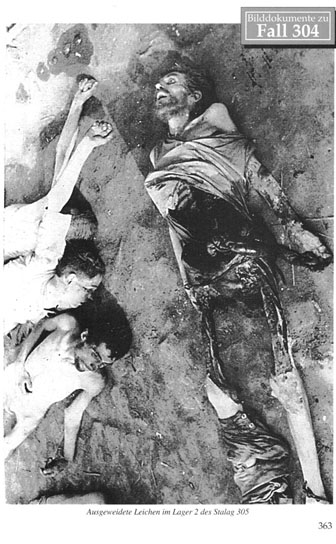
Pictorial documentation to Case 304
Gutted corpse in Camp 305
Page 364]
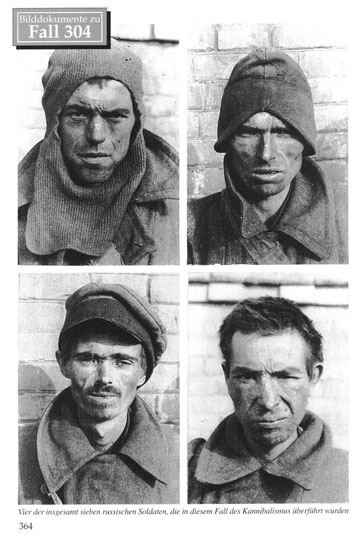
Pictorial documentation to Case 304
Four of the seven Russian soldiers convicted in this case of cannibalism.
Page 365]
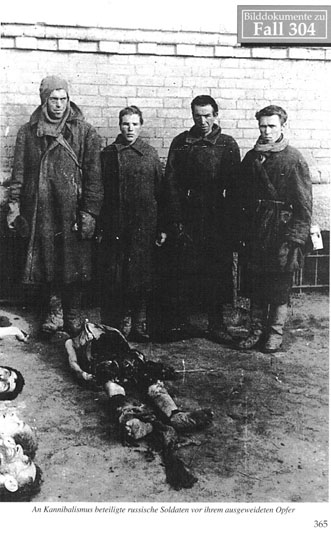
Pictorial documentation to Case 304
Russian soldiers having participated in cannibalism before their gutted victim
Page 366]
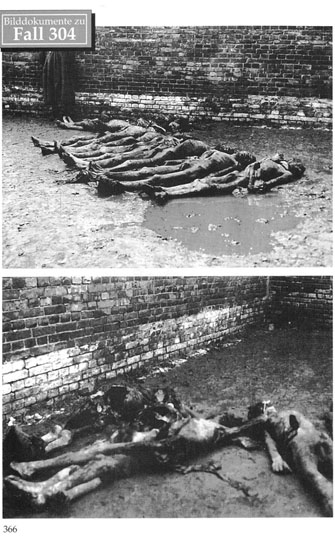
Pictorial documentation to Case 304
Page 367]
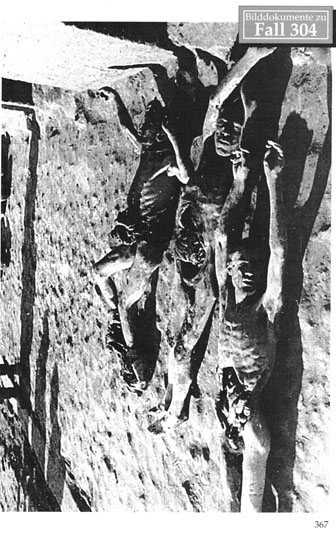
Pictorial documentation to Case 304
Page 368]
who then cut out the missing fleshy parts and ate them. This was confirmed by the investigations conducted Based on the statements of 8 Russian POWs, 6 Russian POWs were identified as perpetrators. These 6 Russian POWs, when questioned, immediately admitted committing the murder and earing the flesh. According to my recollection, the perpetrators were almost all Asians; only one was a Russian.
“Since this case, no more cases of cannibalism have occurred. But the effective strength of the camp has been greatly reduced, since a large proportion of the POWs have been assigned to work commandos or transferred to other camps.:
Read out, approved and signed. Signed signature.
The witness was duly sworn.
Case 305
The attached documents prove other cases of cannibalism: in one of the camps evacuated by the Russians, the body of a Russian was found whose abdomen and thighs had been placed over a fire. The report of Oberfeldwebel Thiel confirms the discovery of two dead German soldiers from whose bodies the Russians had also cut pieces of flesh.
Case 306
The annexed report reports on two Russians who were caught in the act of cutting pieces of flesh out of the bodies of the dead.
Document to Case 306
Battalion from Hassel
To the Stuppi Regiment, 24 February 1942
Subject: Taking of Russian POWs on 24 February 1942
Reference: Telephone call of 24 February 1942.
During a scouting mission in the evening of 23 February 1942, 2 scouts from the battalion s on the supply route between B VII and IX came under fire. The shots came from the forested area behind our main front line. The Battalion thereupon combed this area for concealed Russians on 24 February 1942. 20 men from the regimental supply train of the 127th Supply Regiment went into action led by Corporal Zimmermann.
Corporal Zimmermann reported as follows upon his return:
“At about B VII, I ordered my men to spread out and search the terrain in the direction of B XI. After about 600 m, I saw a new track in the snow, which I followed for 300 m. Then I turned back again and rejoined my men.
“Travelling further along the path, I saw 2 Russians busy cutting pieces of flesh from the bodies of dead Russians. When I called out to them to surrender, they tried to escape and I shot them down. On the spot, I found 2 dead Russians, missing all but the head and ribs. I also found a bread bag filled with flesh meat.
"
I followed the first path again and I saw another 5 Russians seated around a fire, under a tree, roasting meat. I took all 5 prisoner. I took them back to where the slaughtered Russians lay. Using gestures, I asked if they had eaten their own comrades, and they indicated in the affirmative.
“I had to shoot one of these men on the way back, since he refused to go any further. I handed the prisoners over to the Hassel Battalion Command Post.
Signed Signature: Captain and Battalion Commander, Regimental Command Post, 26 February 1942.
I declare under oath that the statements made by me correspond to the truth.
Signed: Zimmermann, officer 8th Company, 27th Infantry Regiment, Local Bivouac, 27 February 1942.
Page 369]
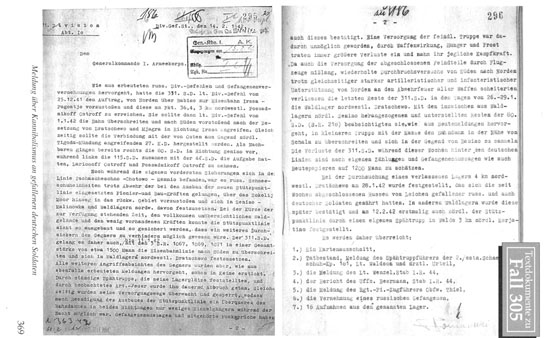
Text document to case 305
Report on cannibalism on dead German soldiers
Page 370]
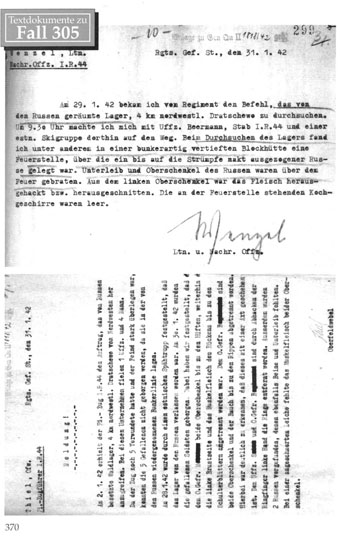
Text document to case 305
Page 371]
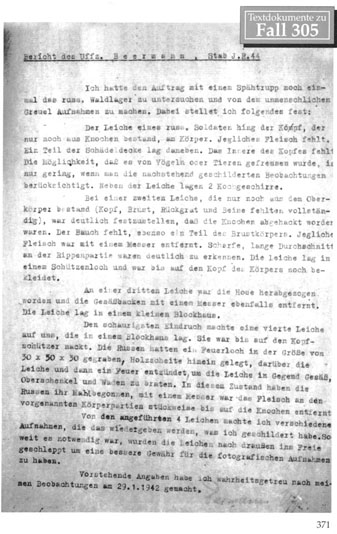
Text document to case 305
Page 372]
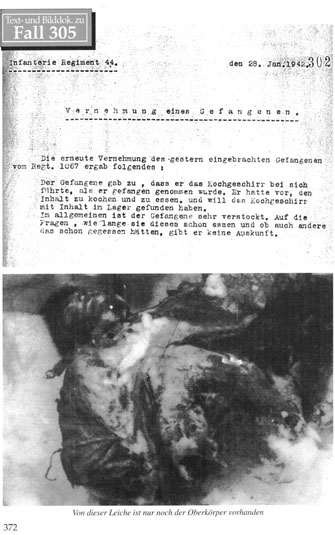
Text and pictorial documentation to Case 305
Only the upper torso of this body was found.
Page 373]
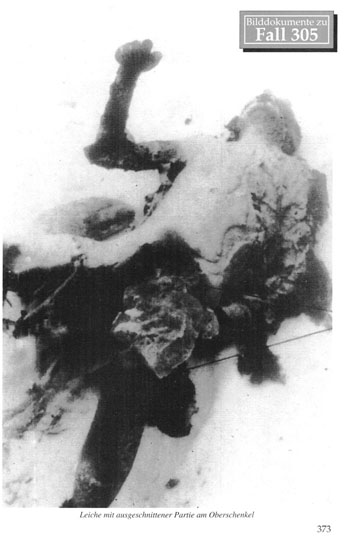
Pictorial documentation to Case 305
Body with parts cut out of thigh
Page 374]
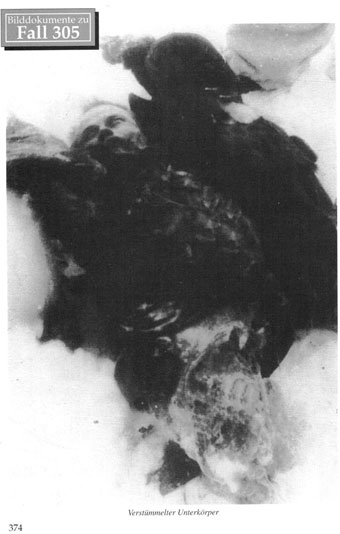
Pictorial documentation to Case 305
Mutilated lower body
Page 375]
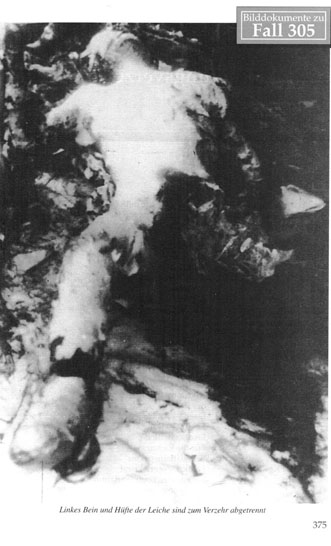
Pictorial documentation to Case 305
Left leg and hip have been cut off the body to be eaten.